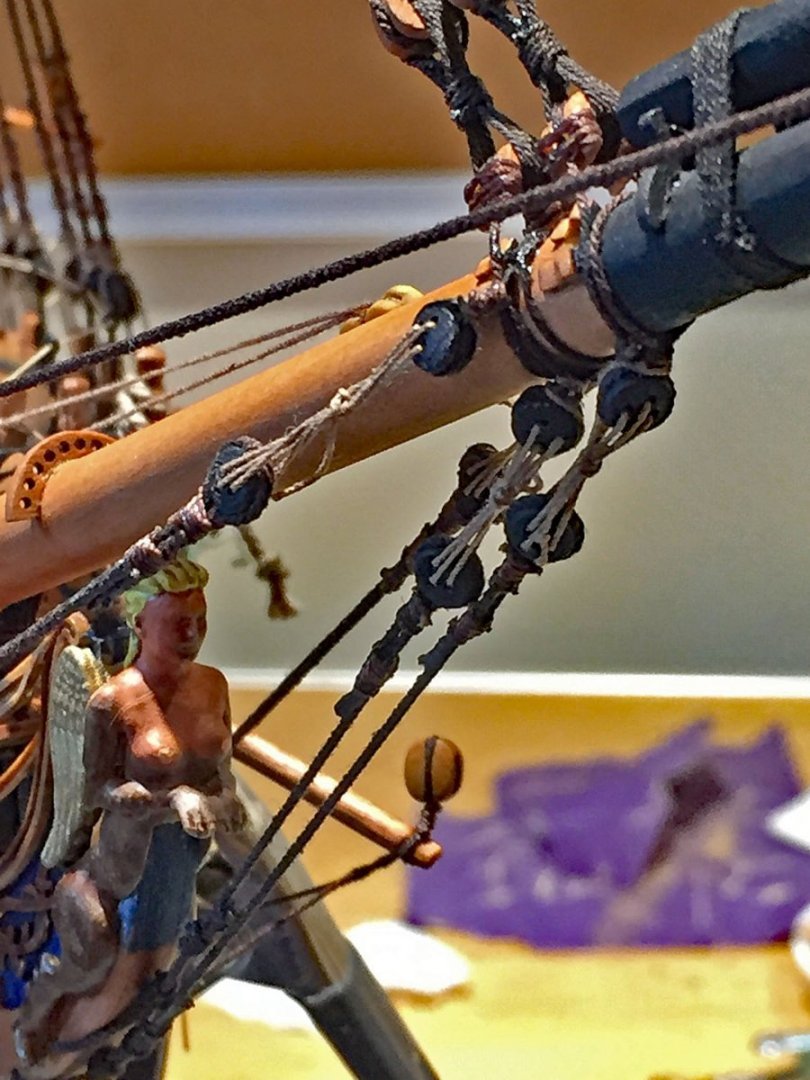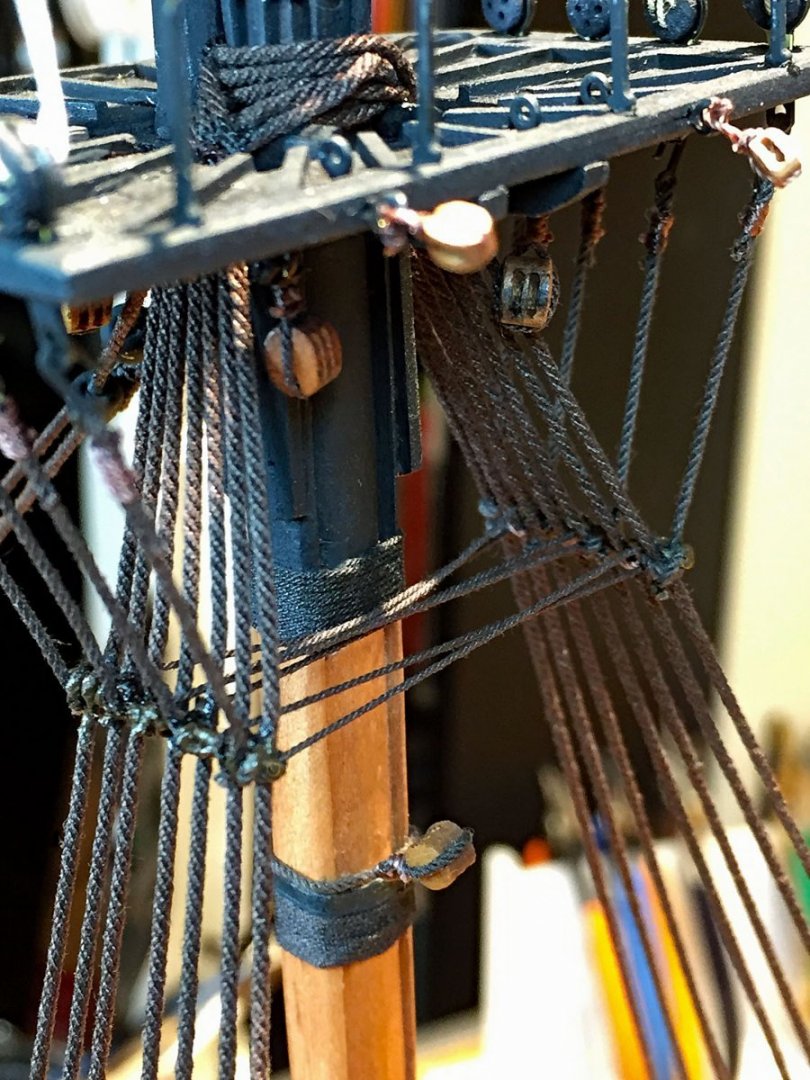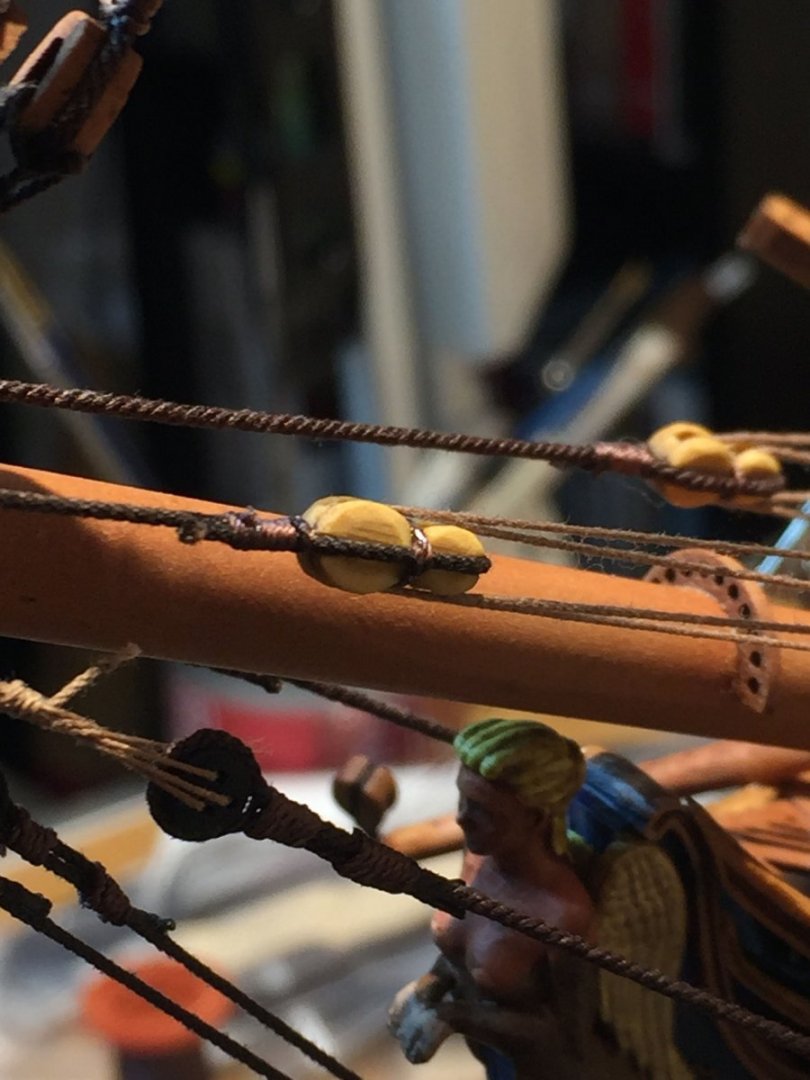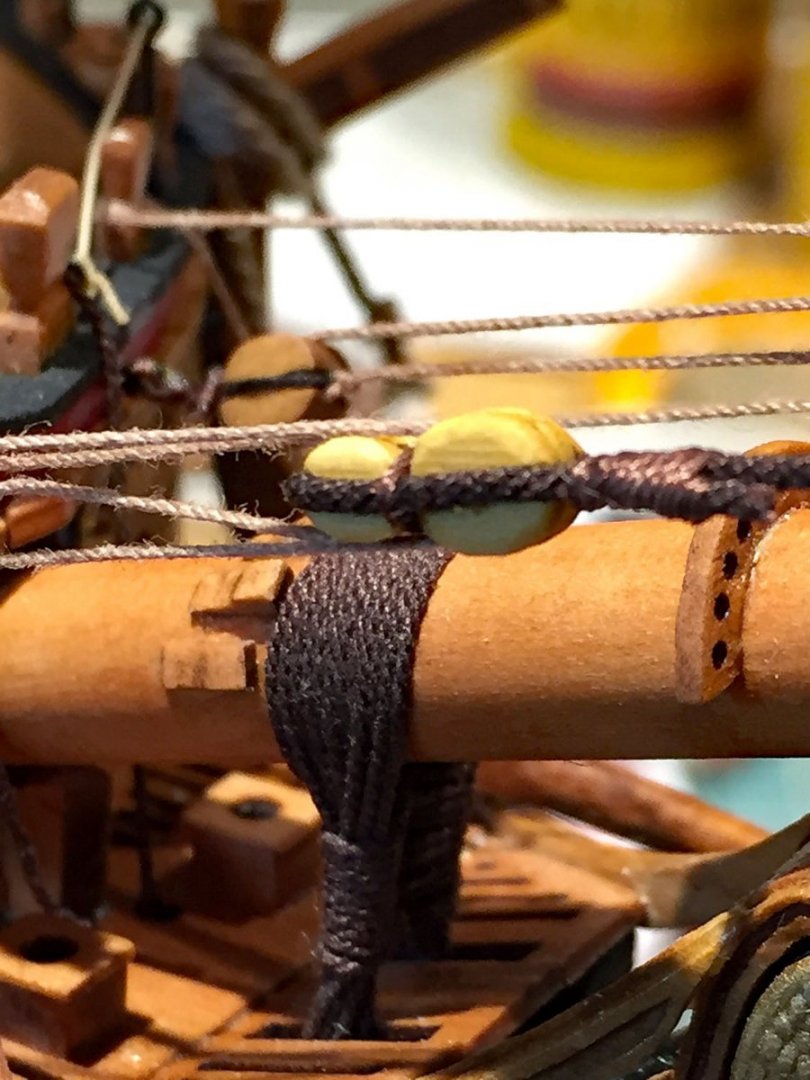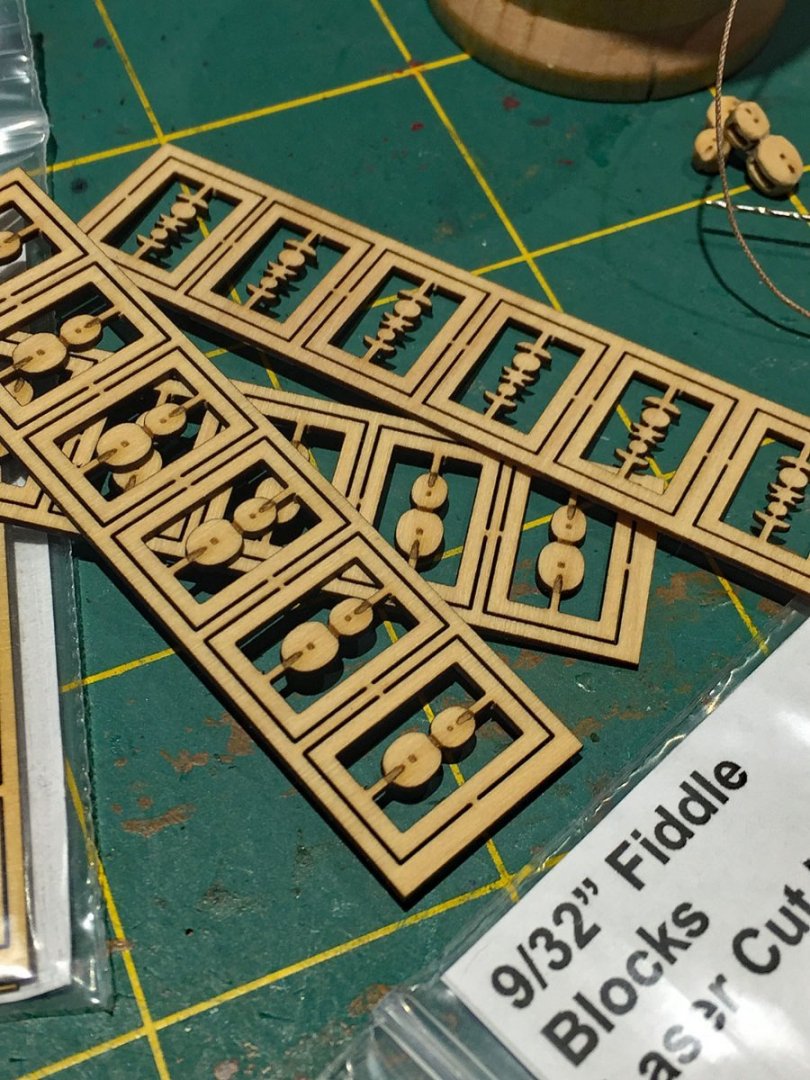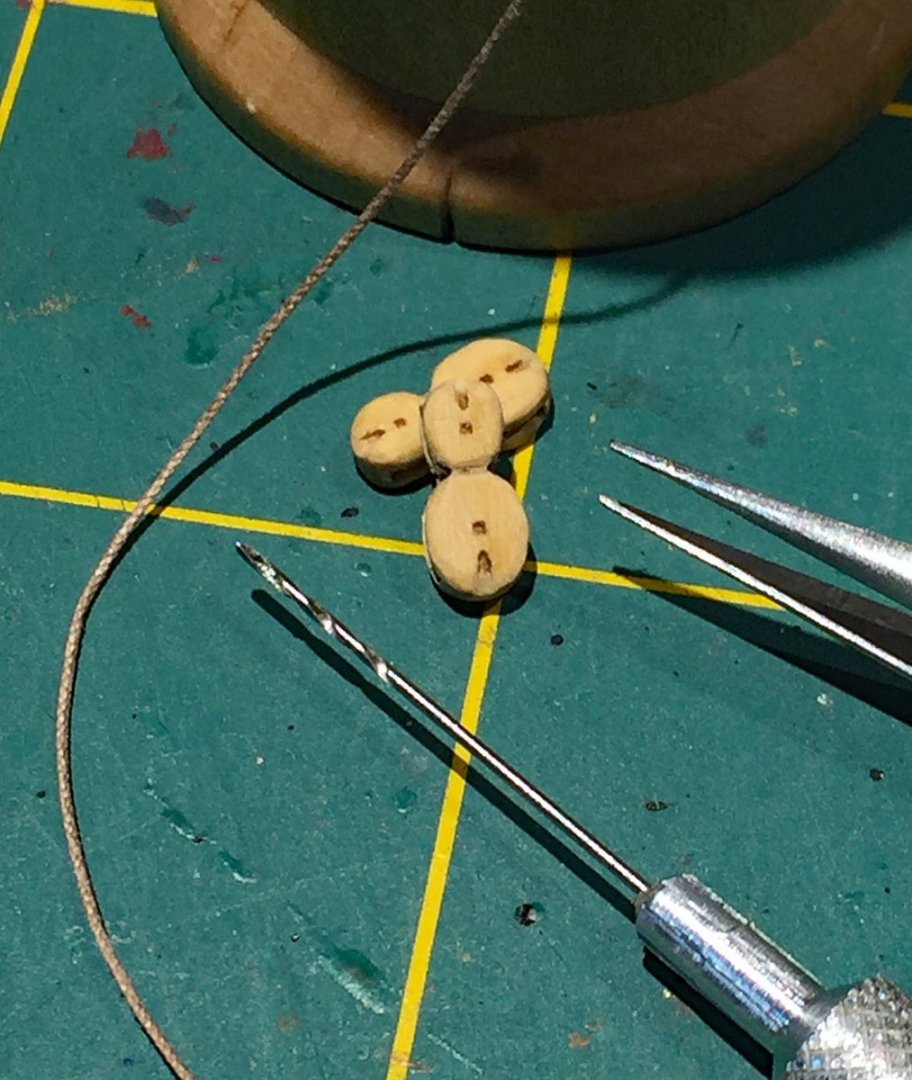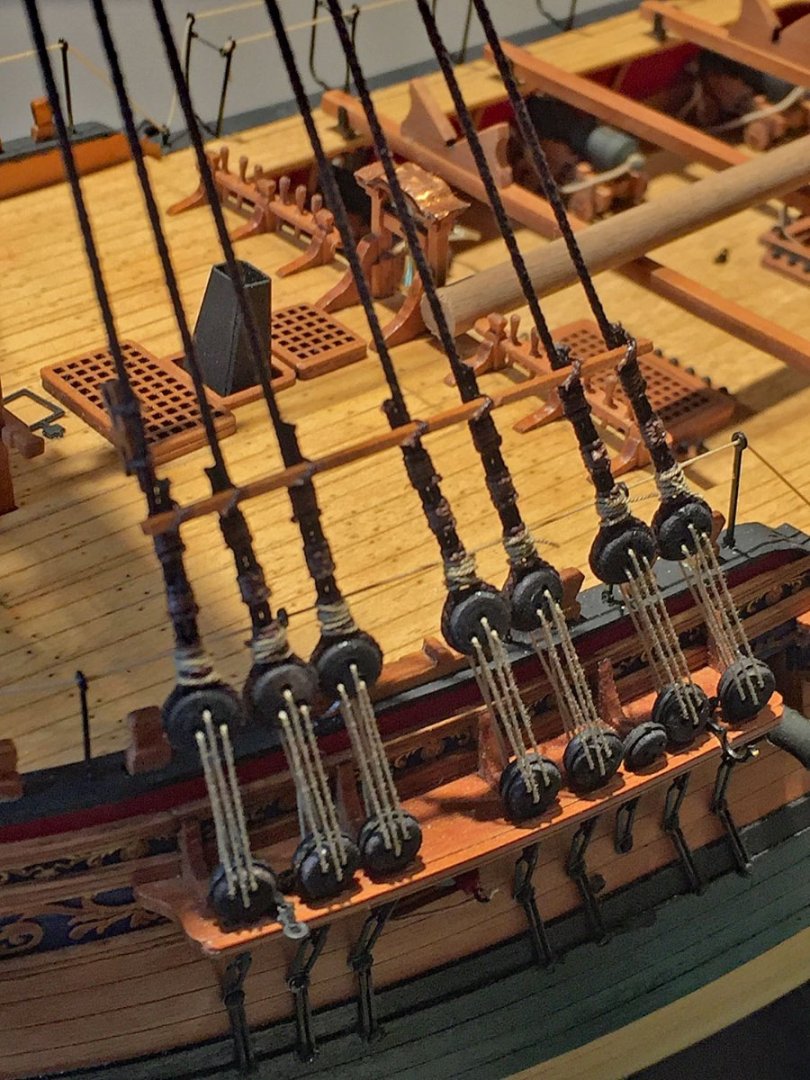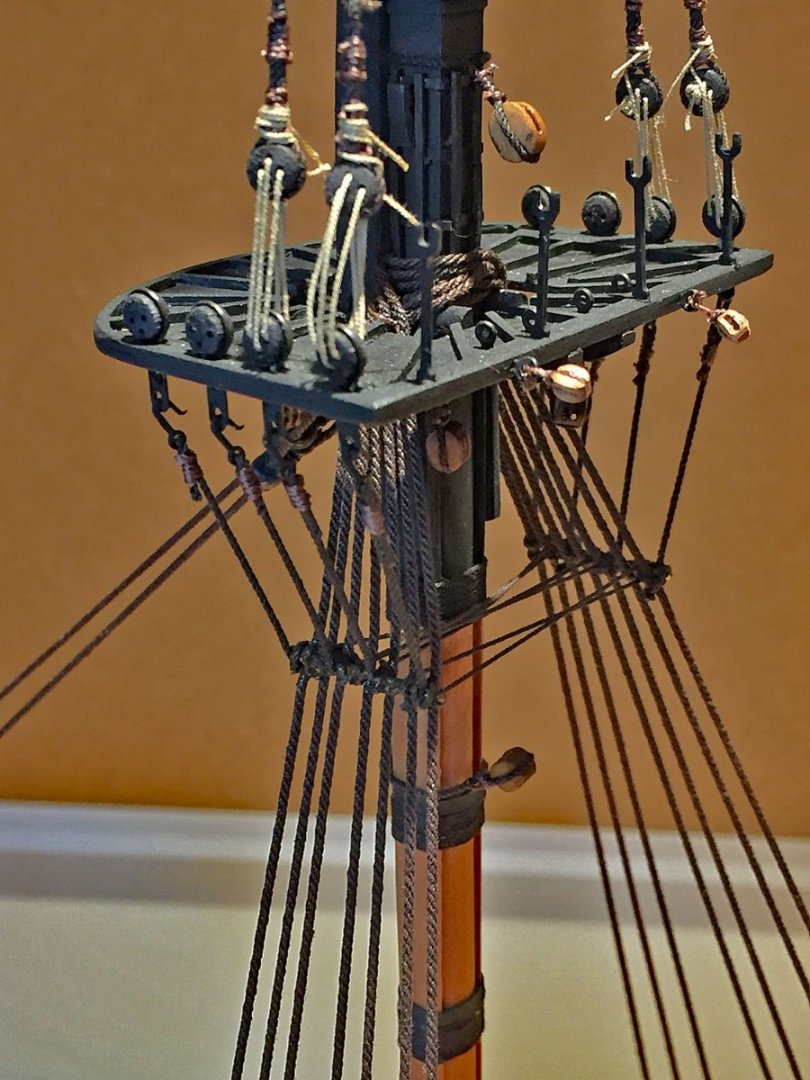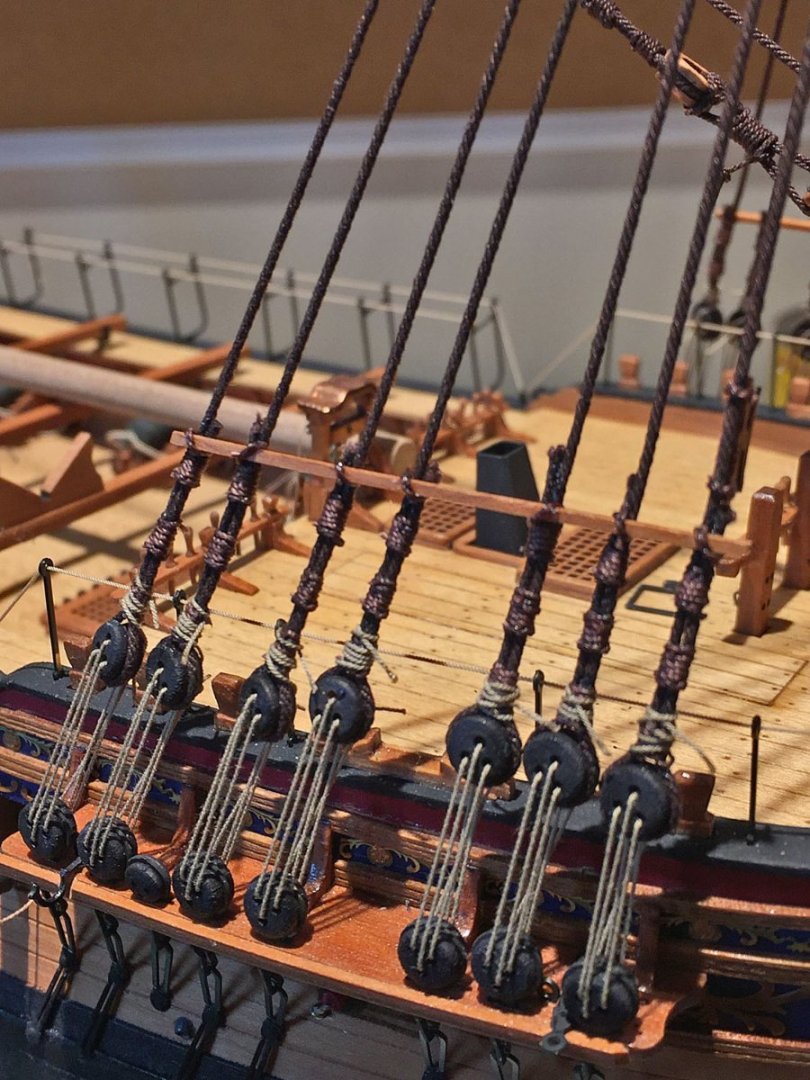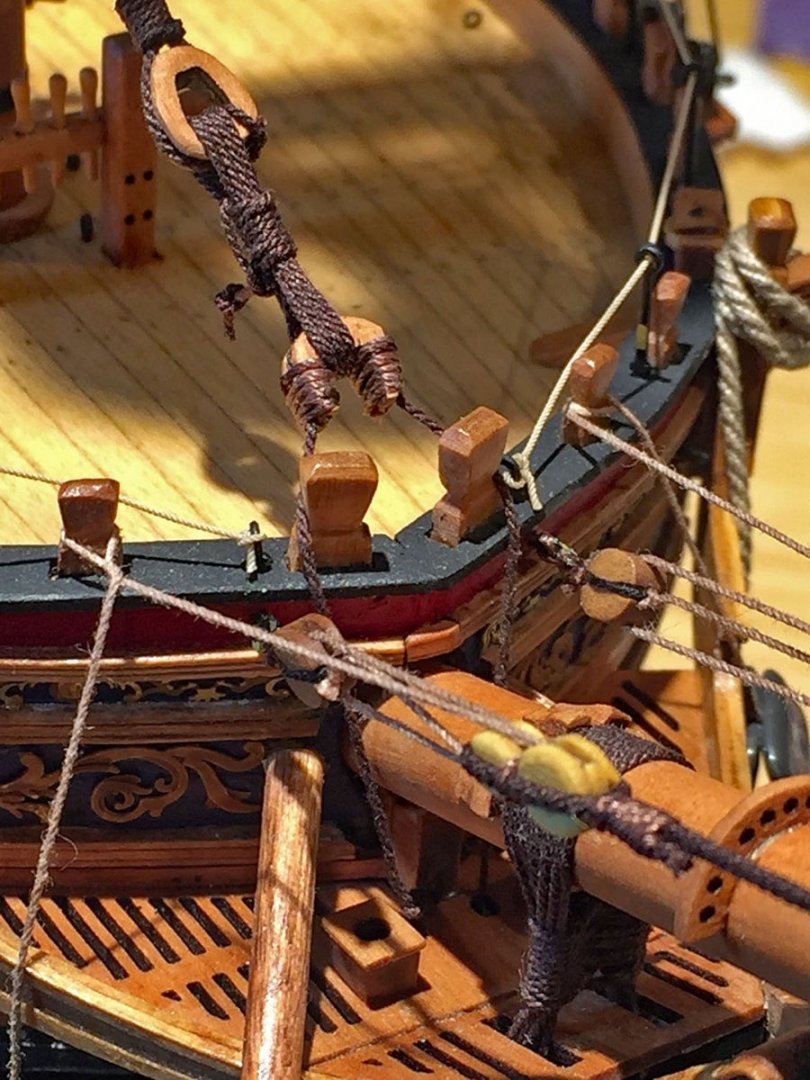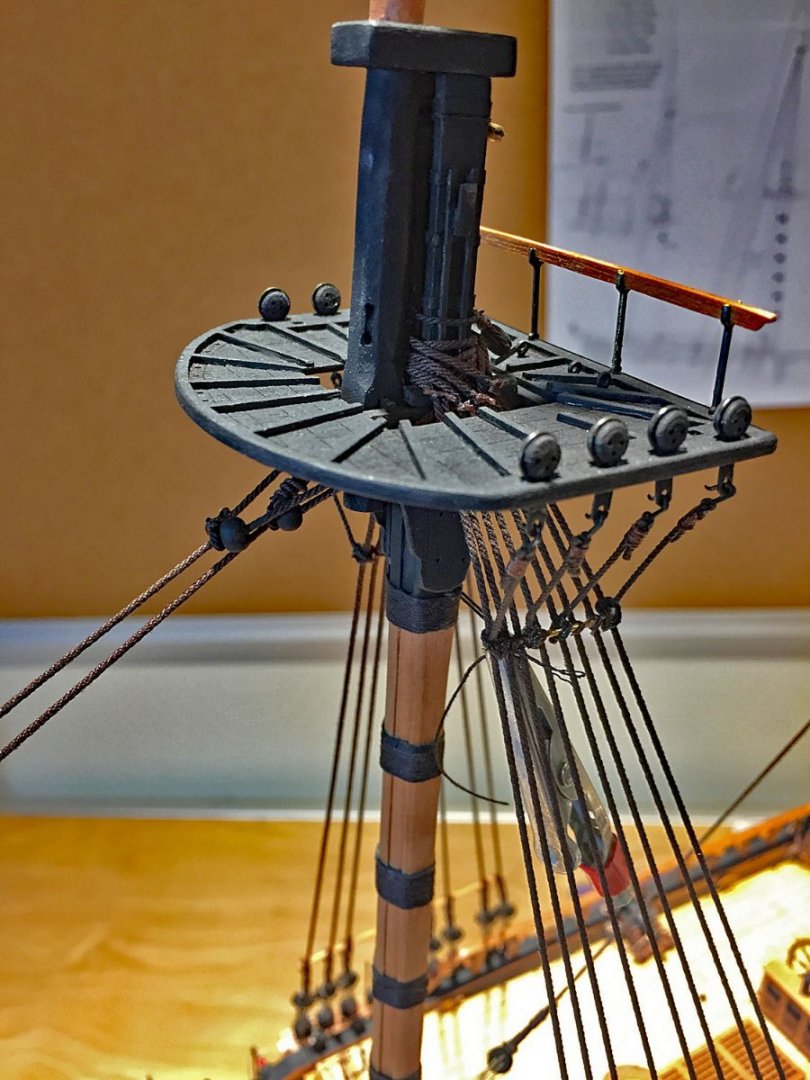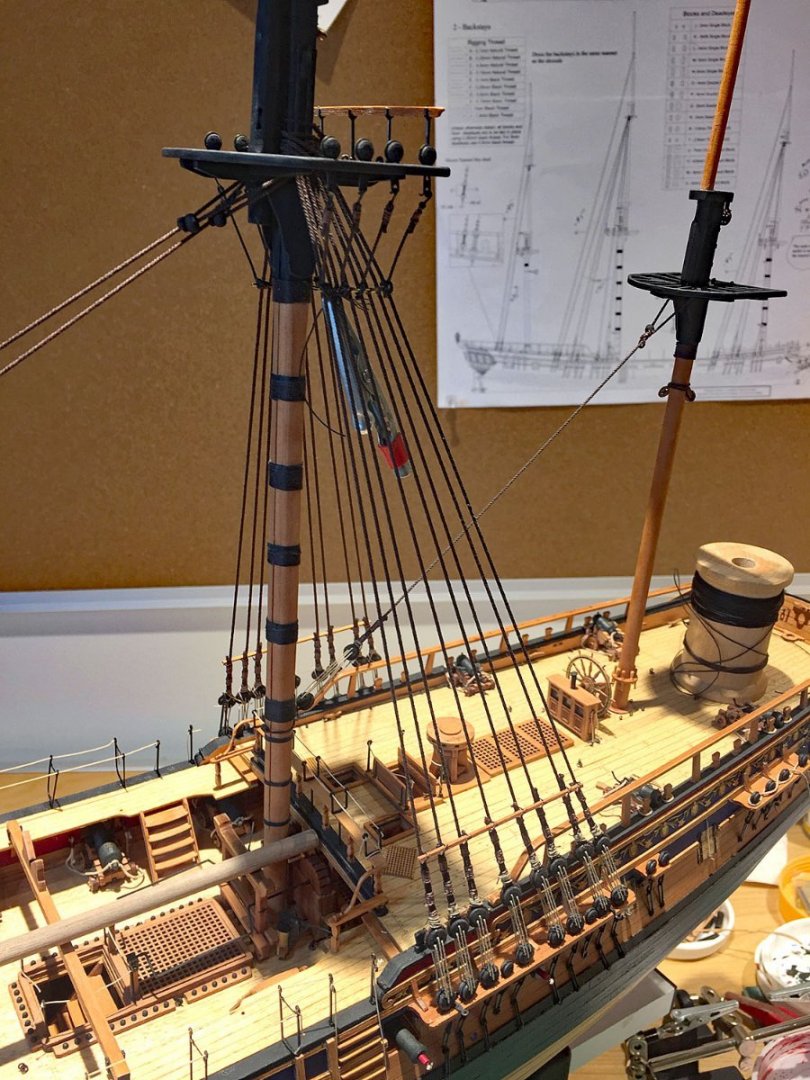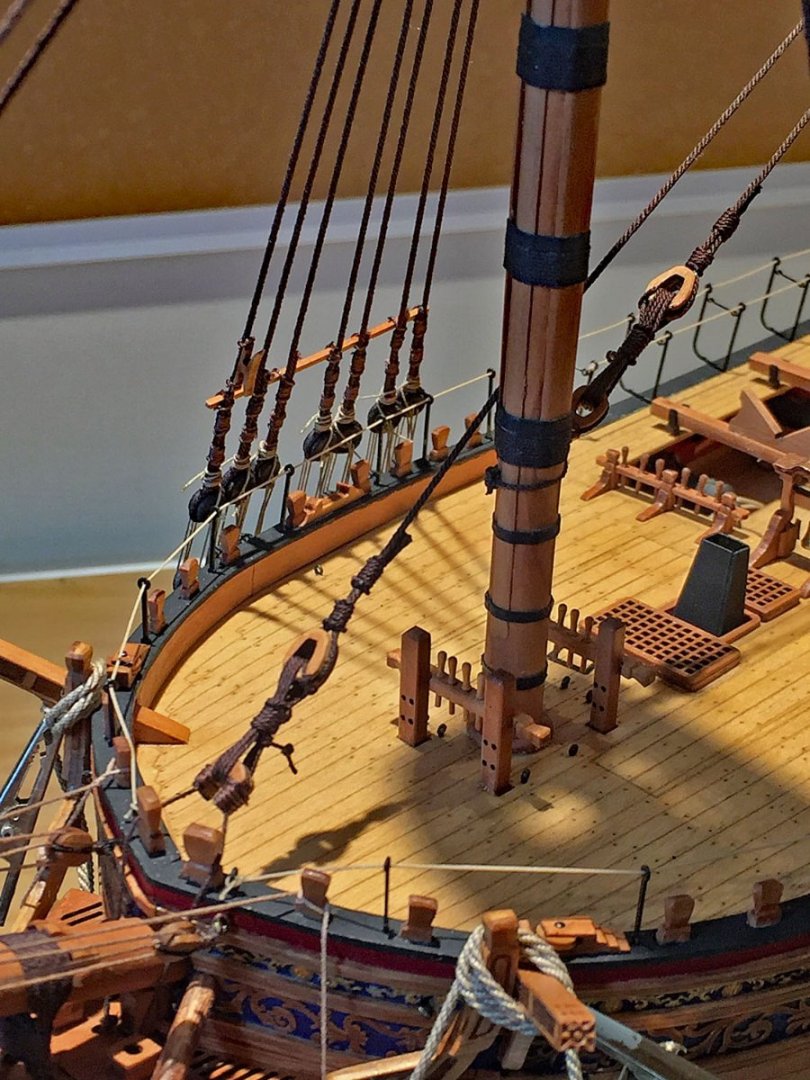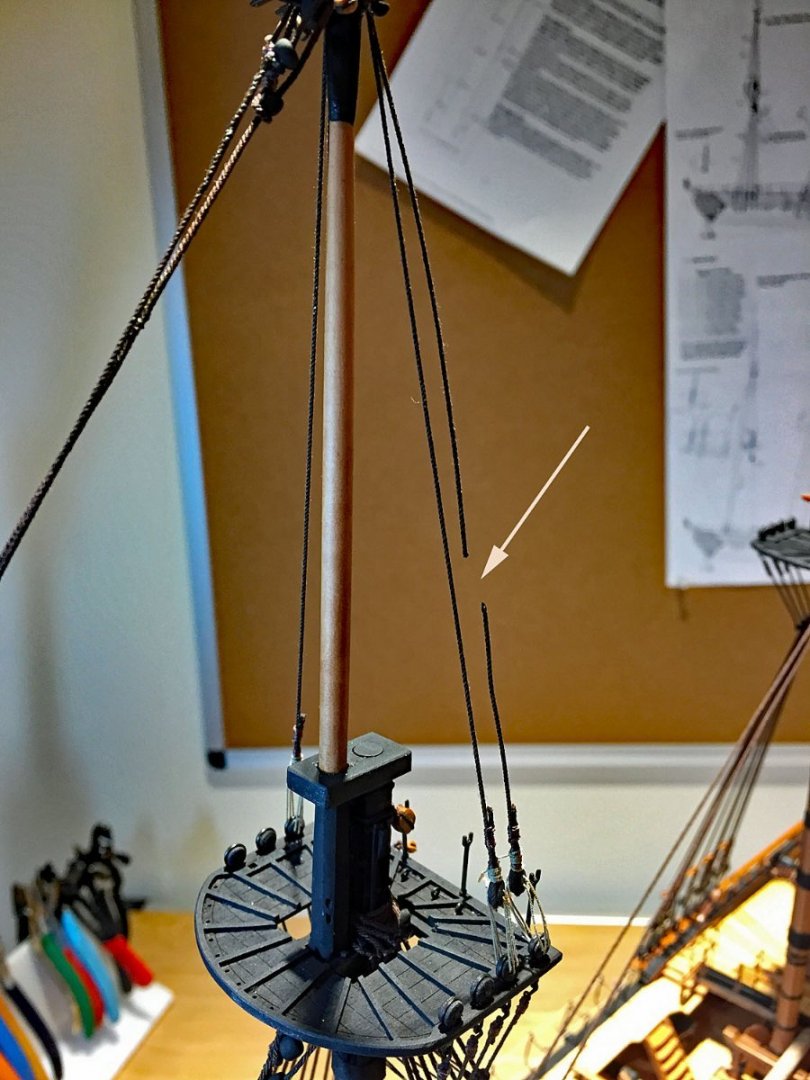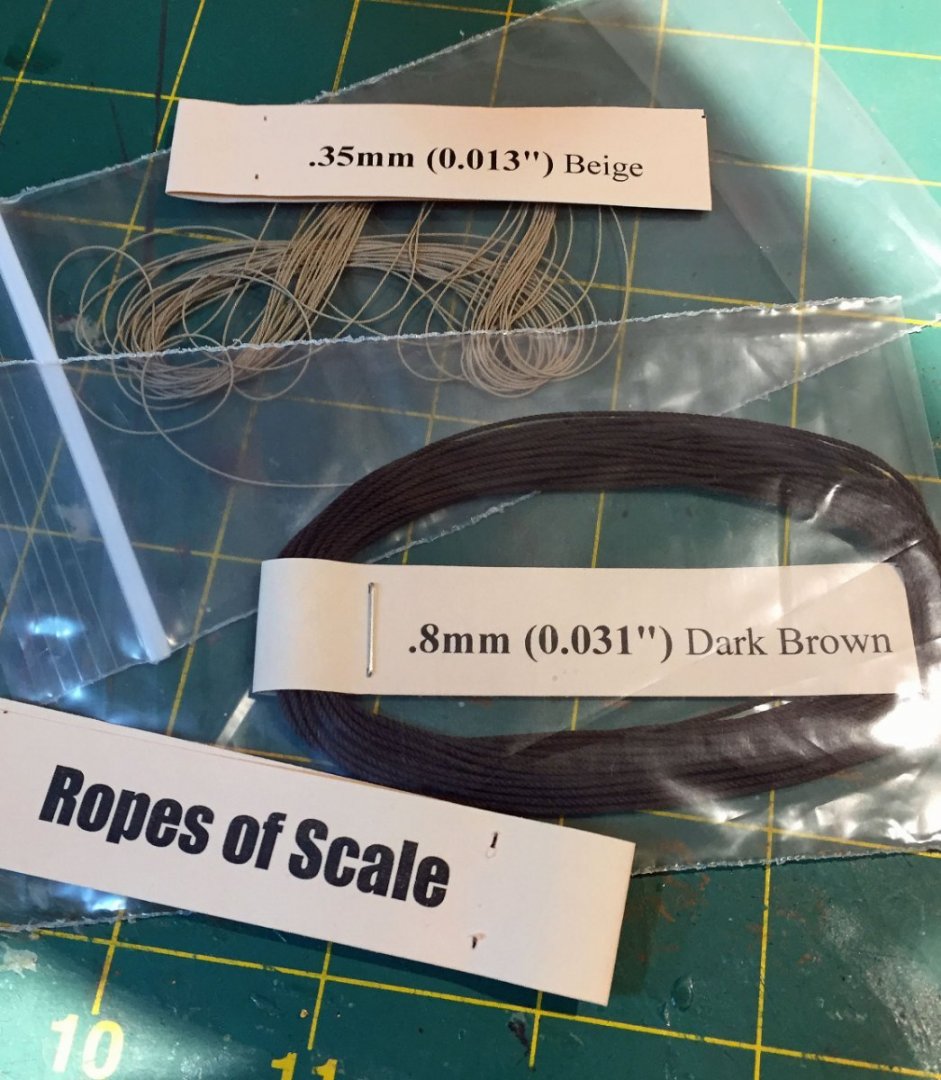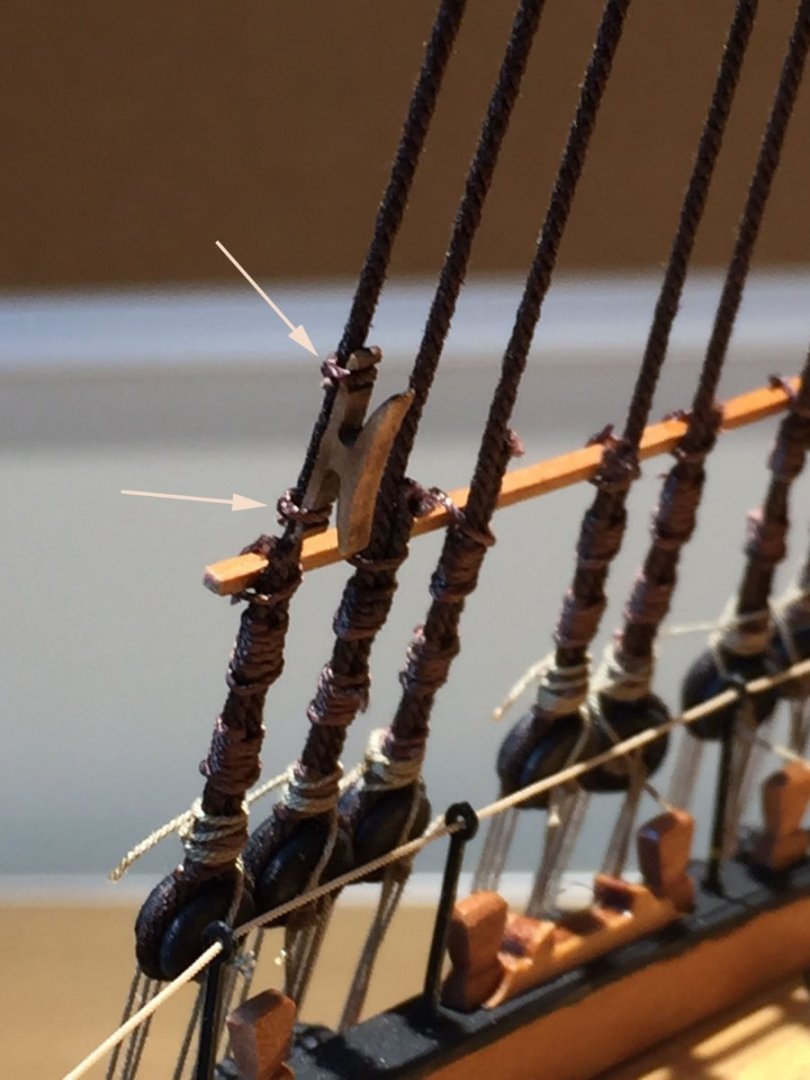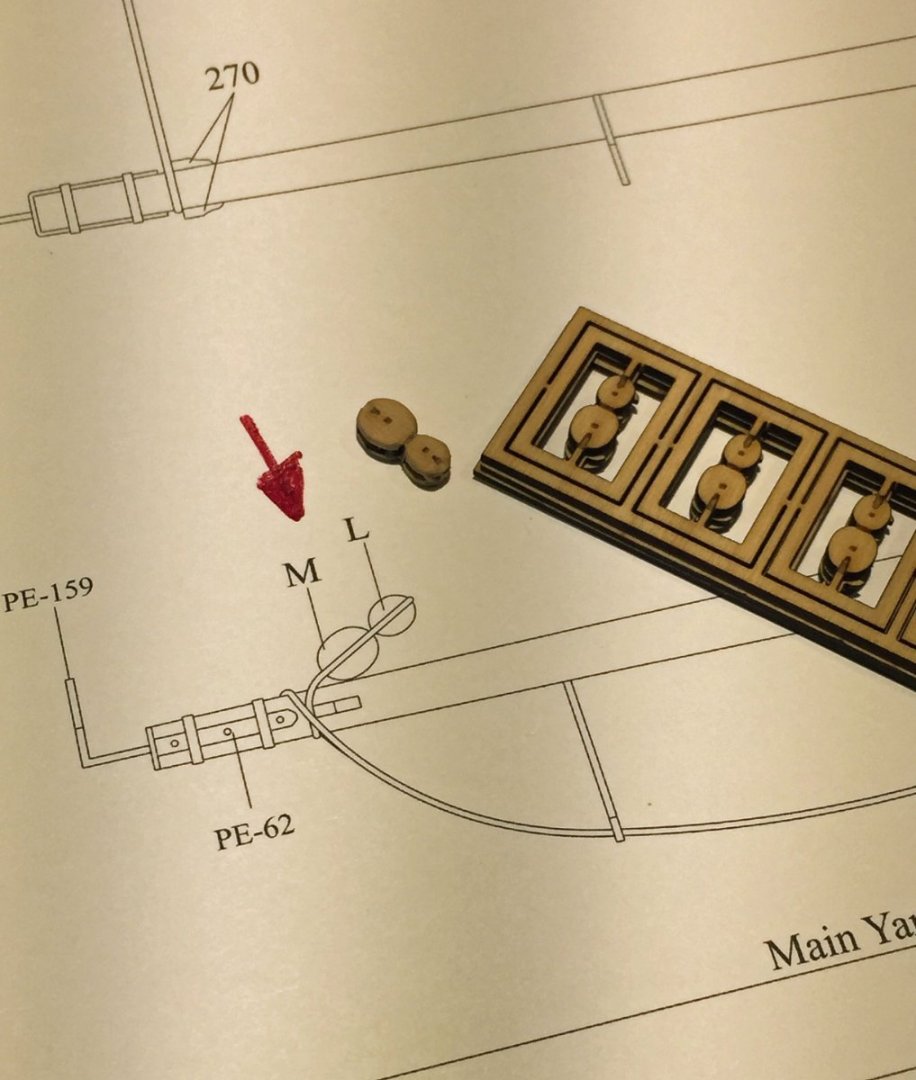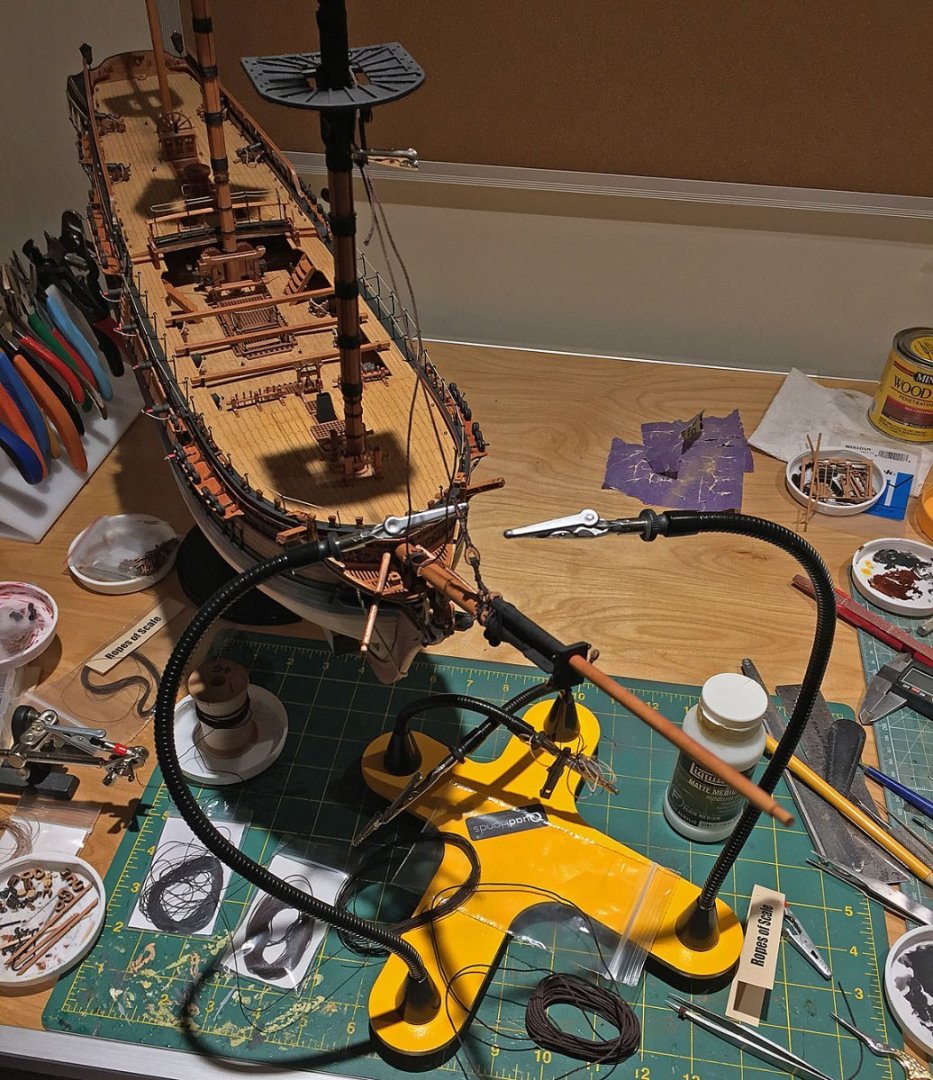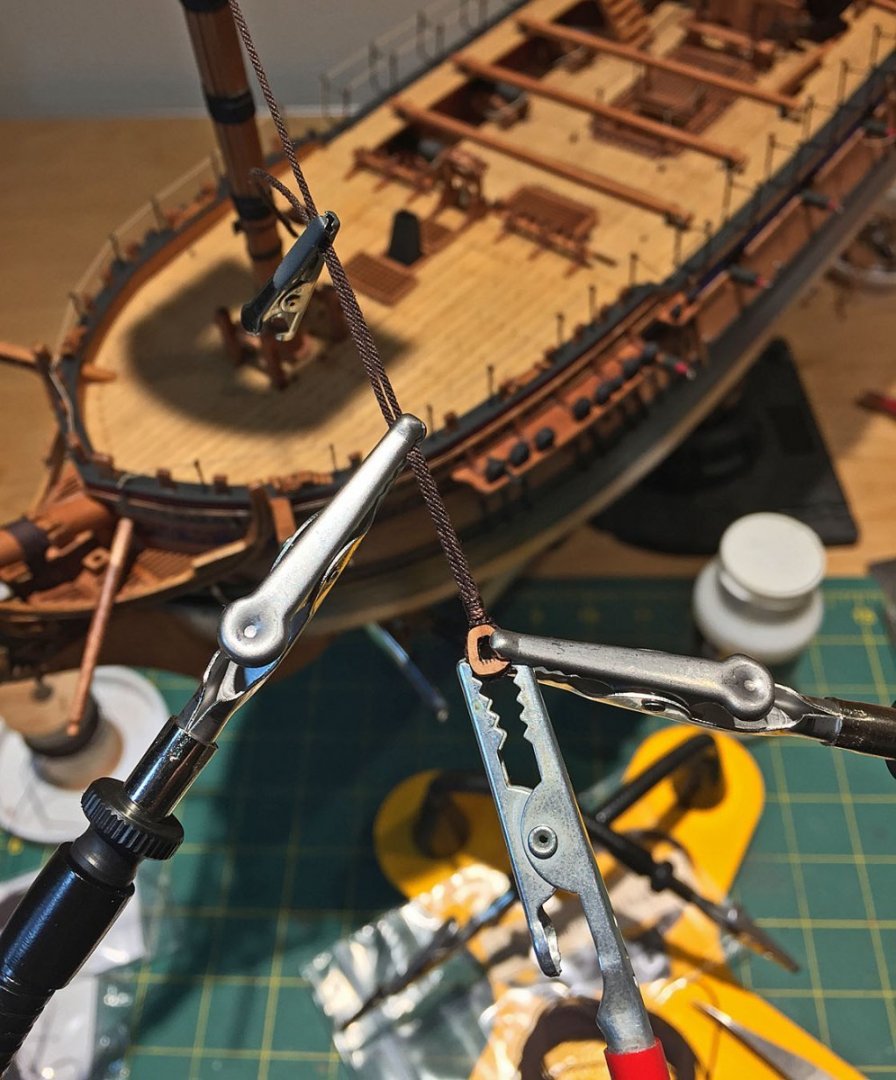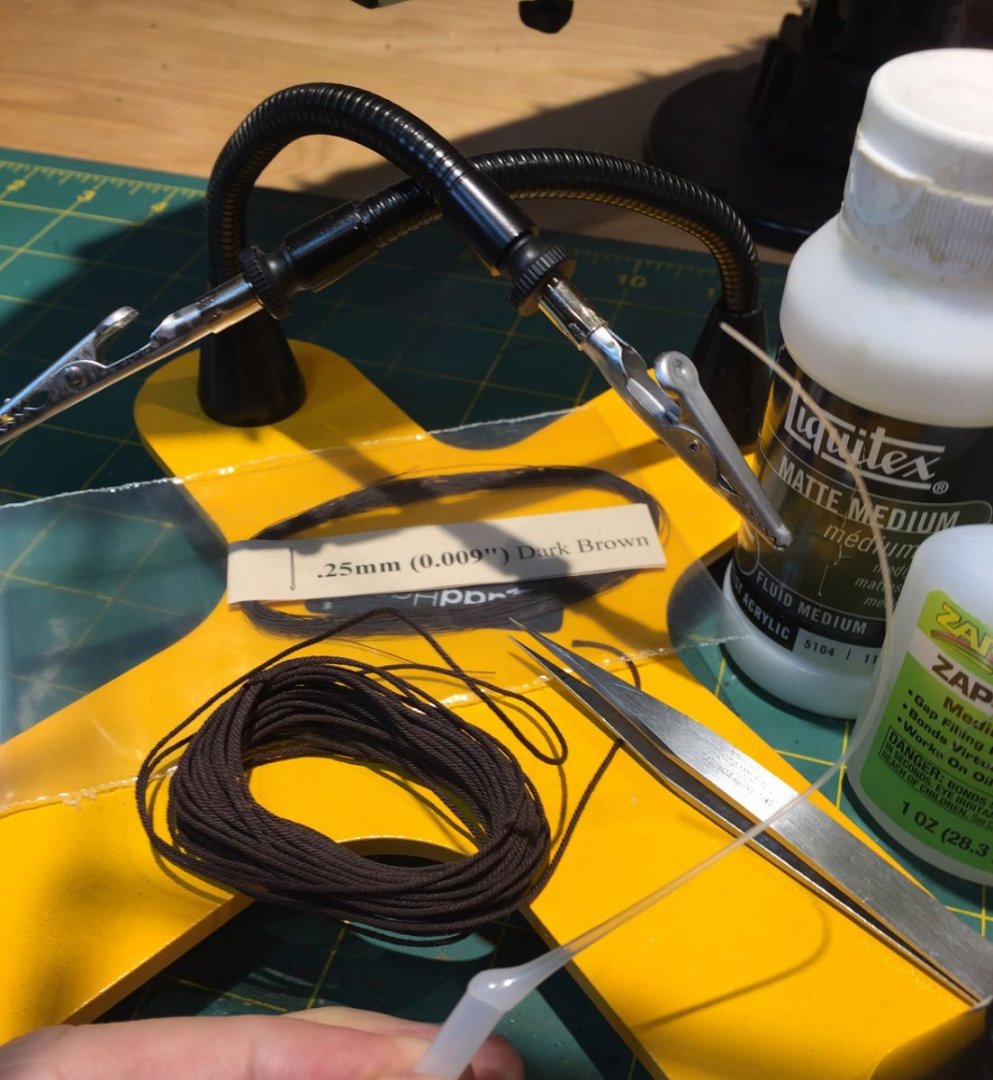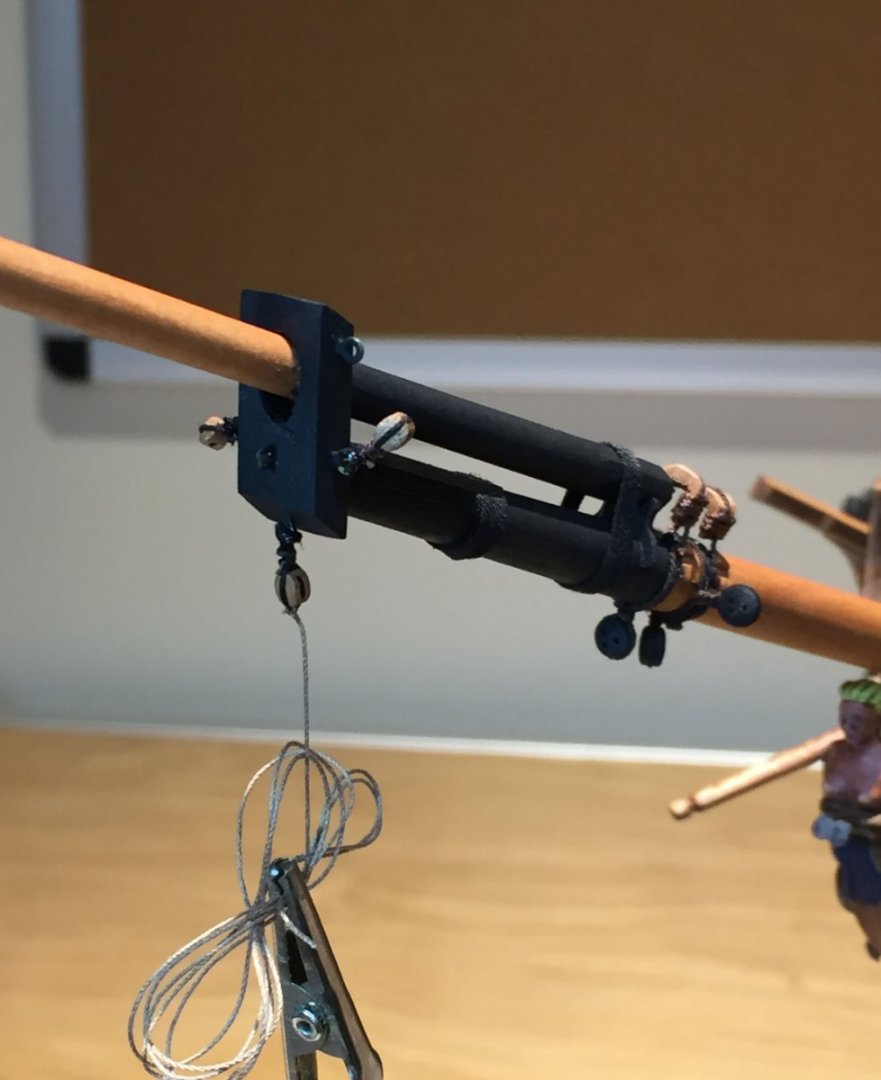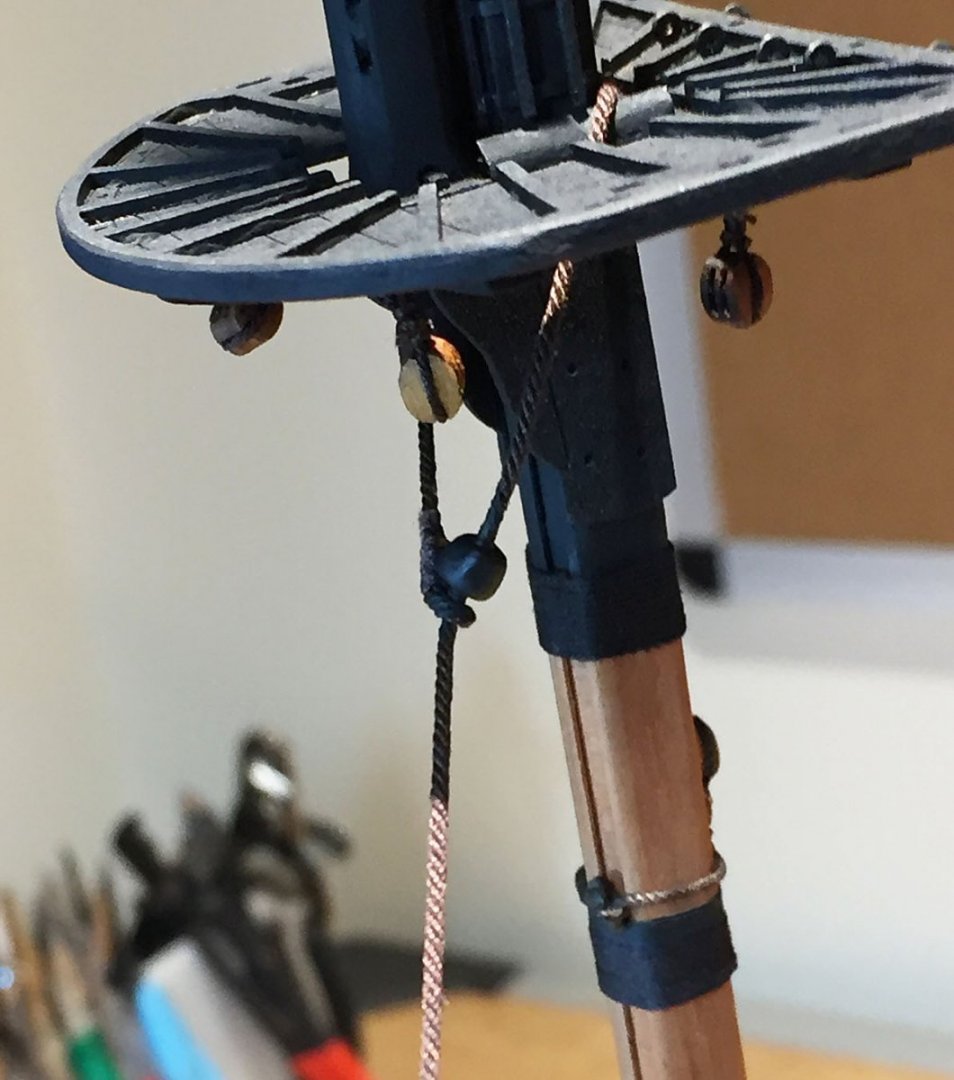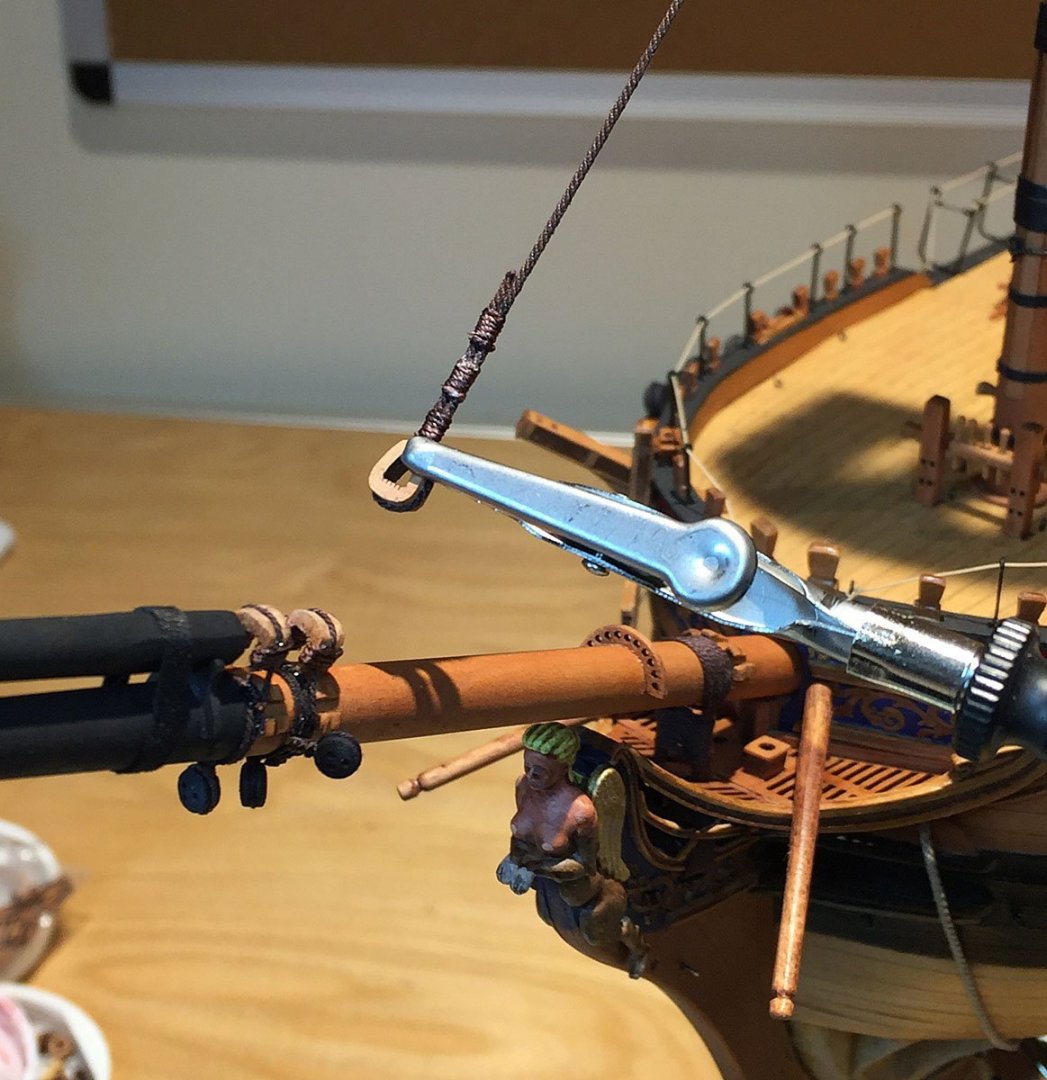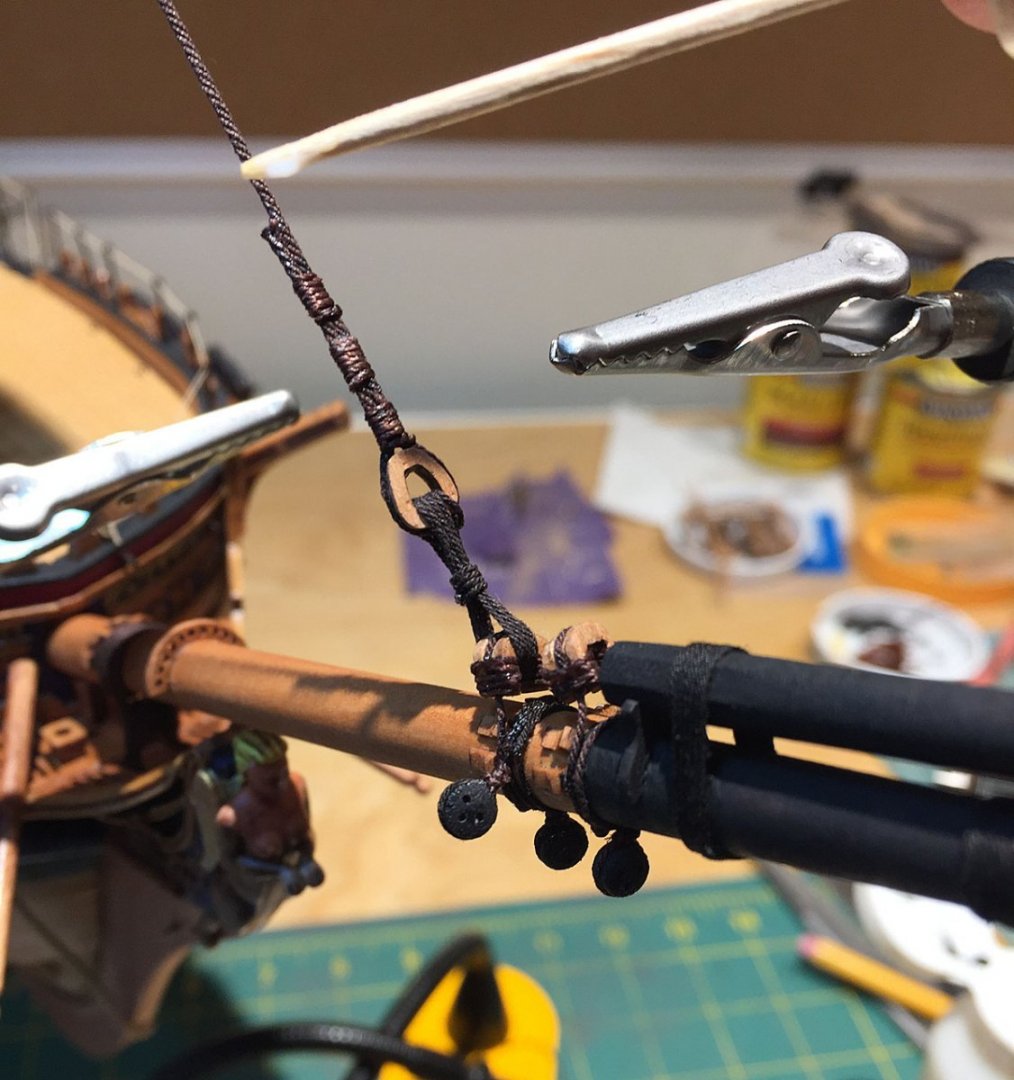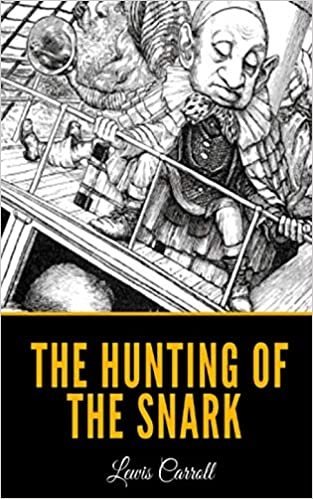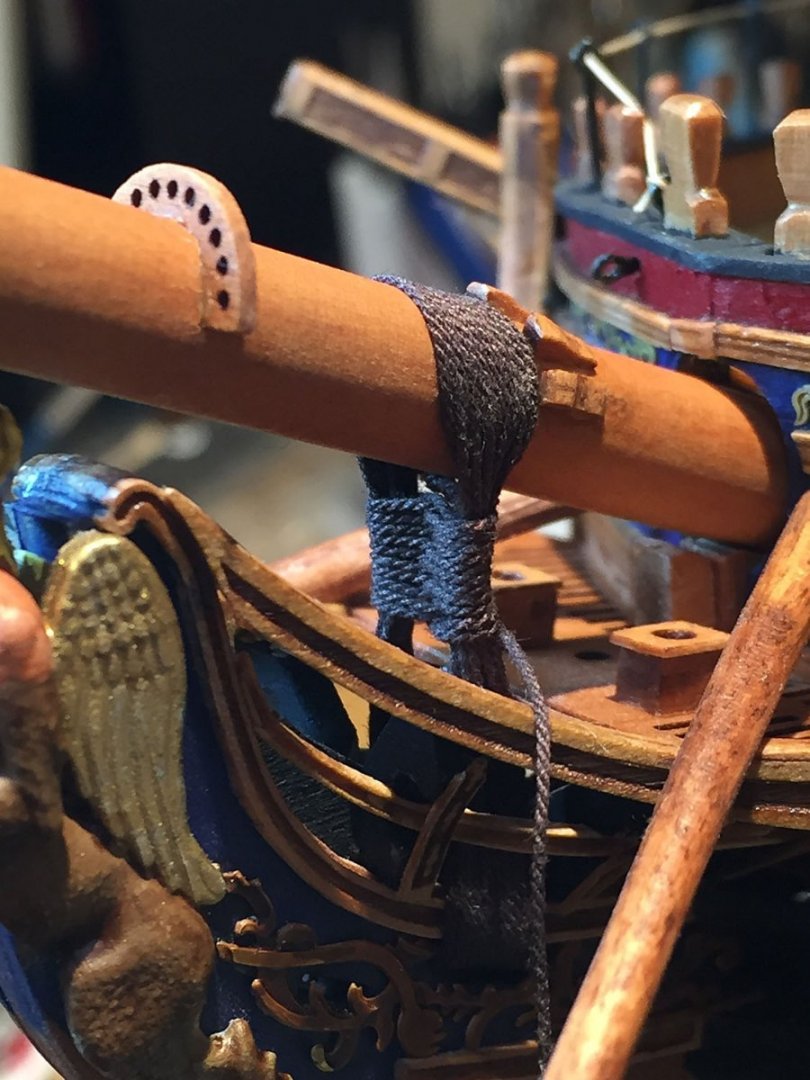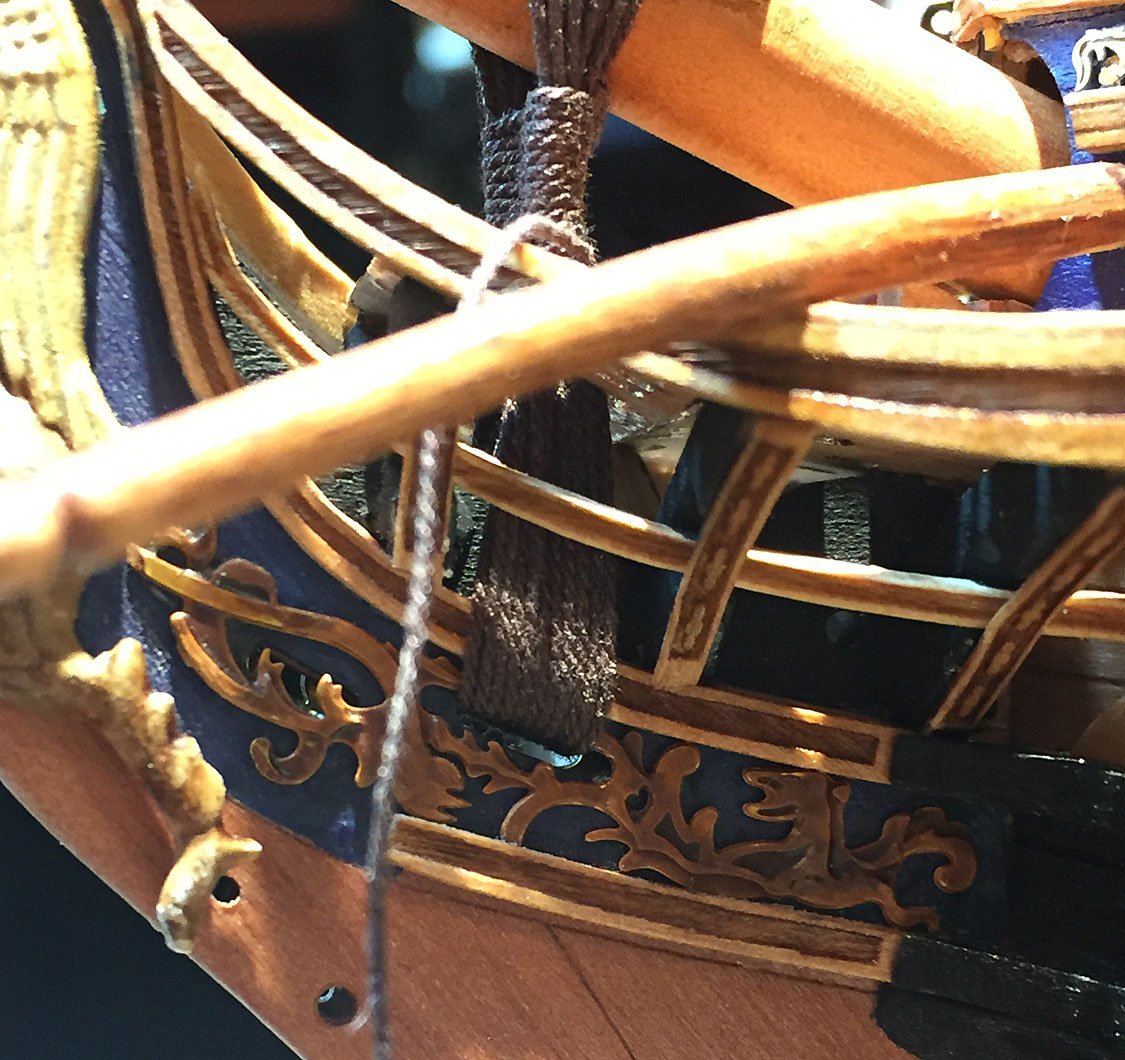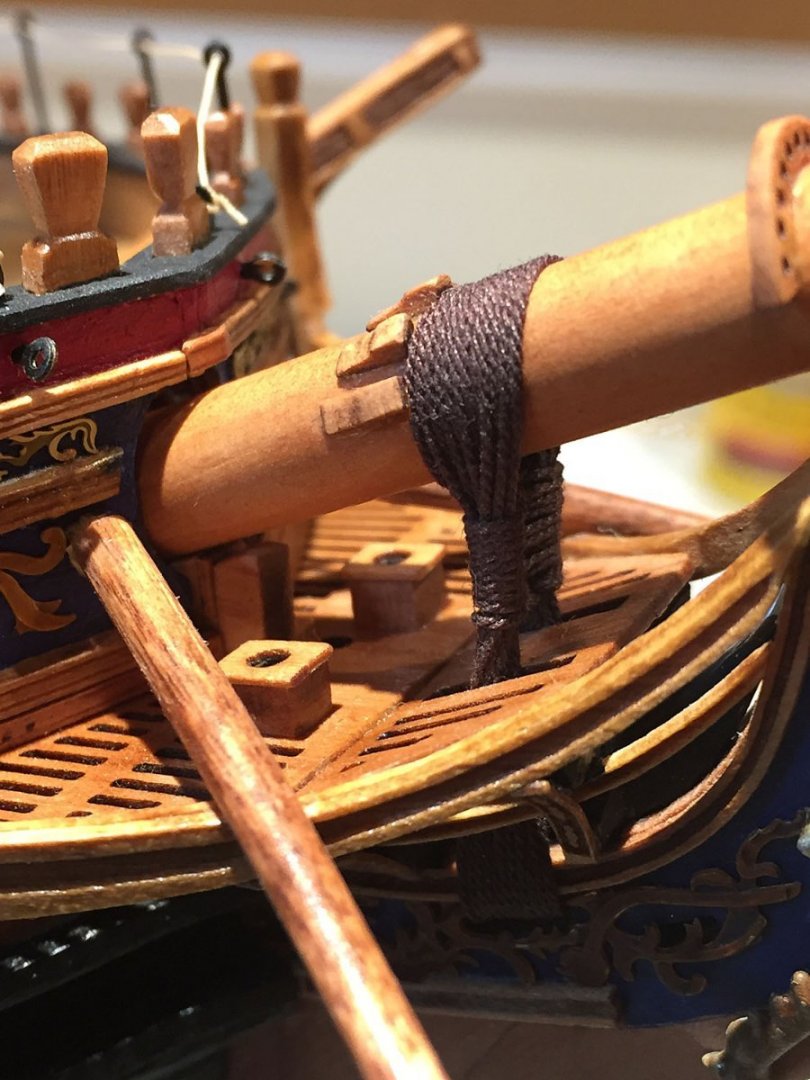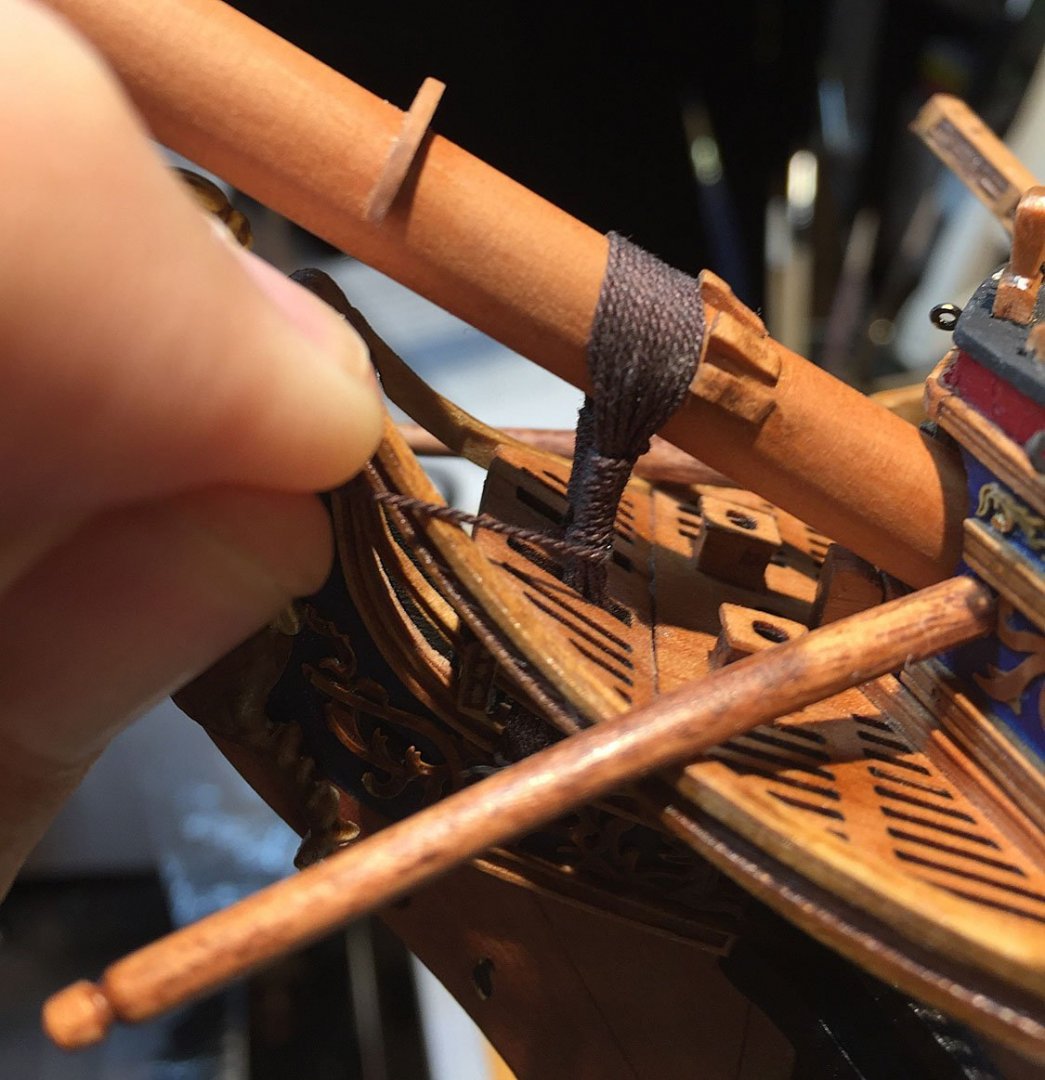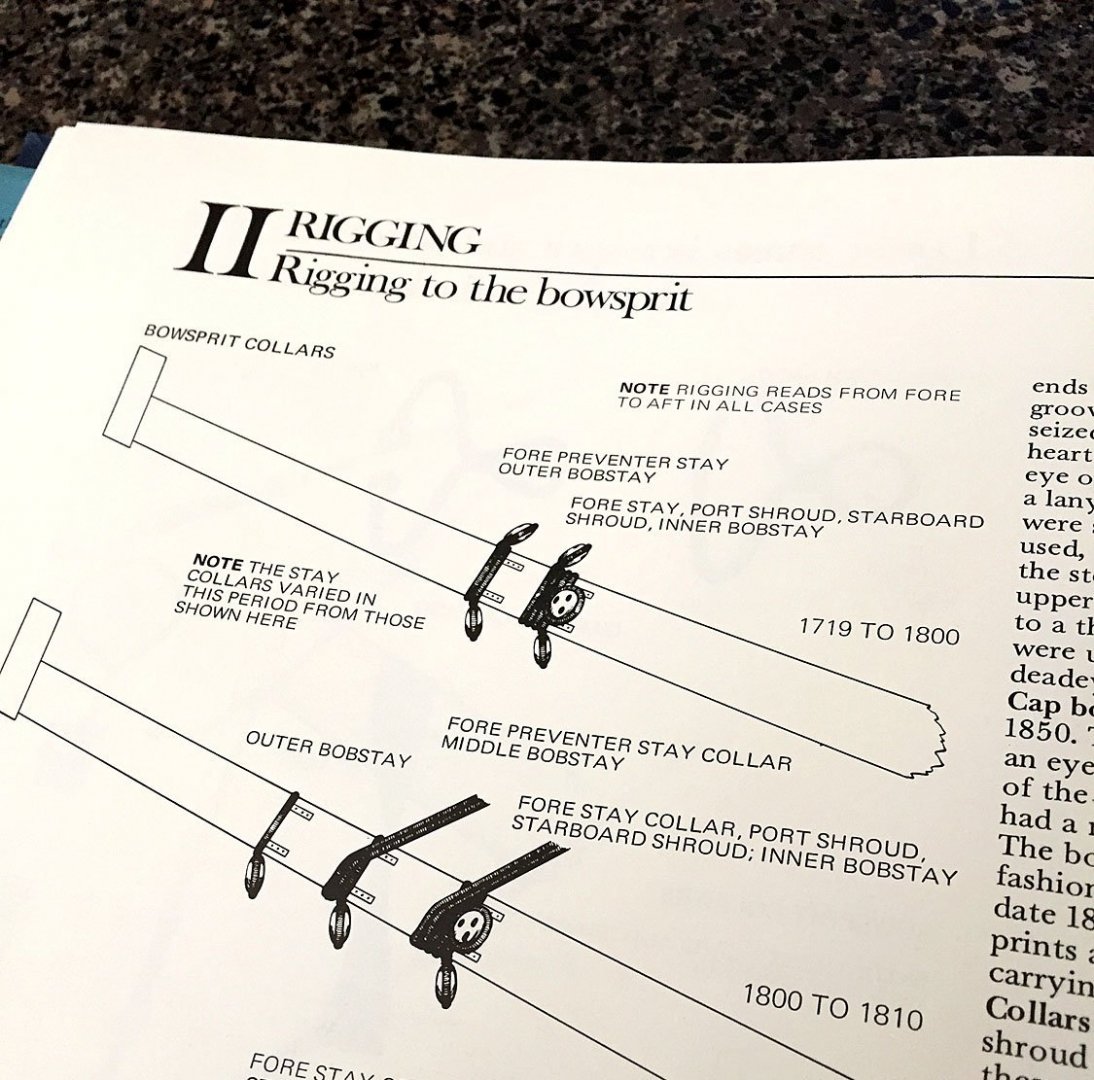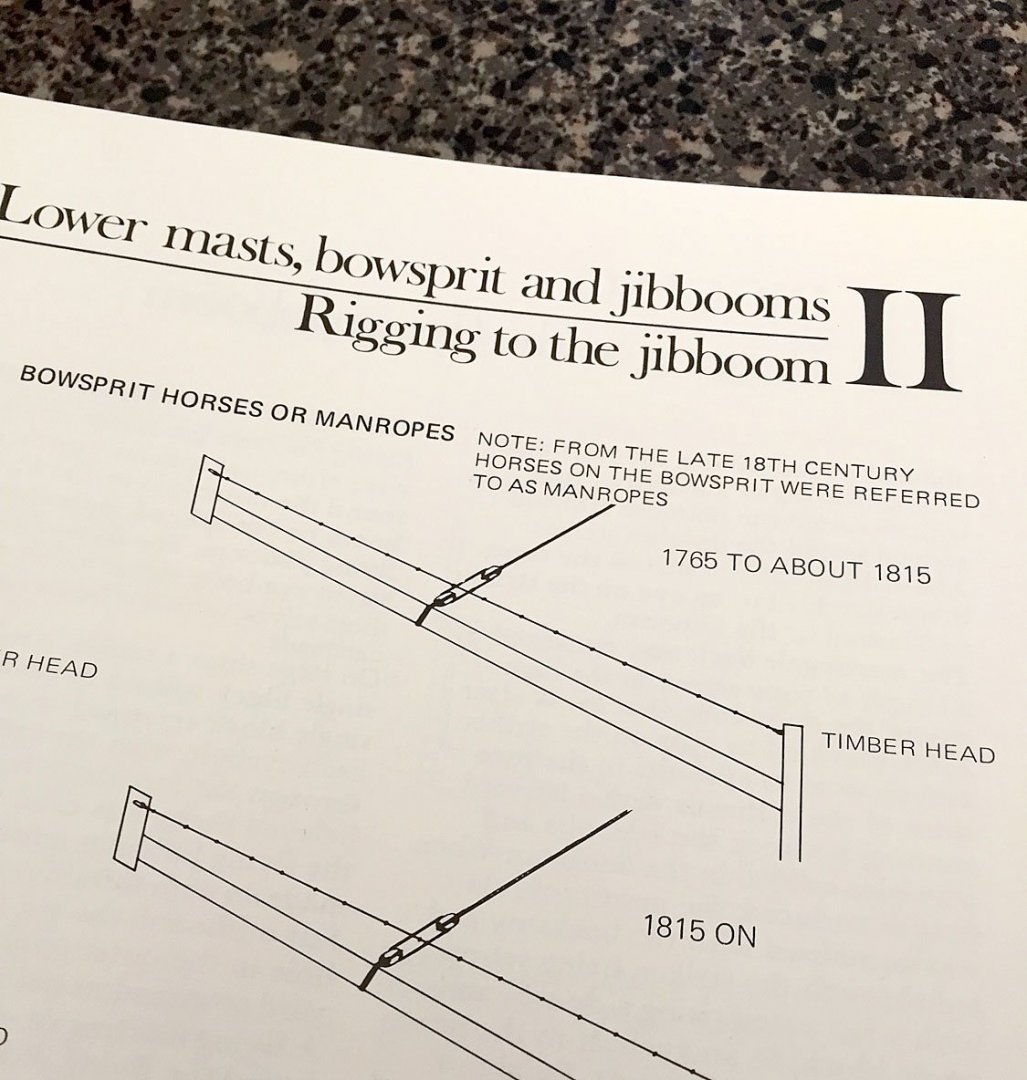-
Posts
1,554 -
Joined
-
Last visited
Content Type
Profiles
Forums
Gallery
Events
Everything posted by hollowneck
-
An update...fell out of the saddle for a few days gentlemen, jumped back up. Here's some progress on Camilla's standing rigging, some details on the rope I've chosen to use on this build and a variety of blocks I'm using (some kit, some other sources). Bobstays. These stays counterbalanced the immense upward pull on the bowsprit exerted by the fore & main mast stays. Four heavy lines run from the bowsprit to the stem and hull. This shroud rigging has blocks that permit tightening of the lines as they loosen over time. The foremast shrouds, futtocks and catharpin lines. The mast wooldings can also be seen in this photo. The catharpins are tied-off to a span of .7mm brass wire tied to the upper shrouds where the futtock shroud lines continue up to the top. No ratlines yet. The fiddle blocks for the fore topmast stays are boxwood; I considered dyeing them to match the other pear blocks I'm using throughout but I did't mind using these here for contrast with the many lines in the bowsprit area which will triple in number by the time all are run-in - including the sail management lines. I will also be using these boxwood fiddle blocks for all the yard lifts. I wish these were available in pear, but I'm really not complaining. A close-up of a lashed and mounted fiddle block at the stem. These tackle blocks have two sheaves of different diameters adjacent to one another contained in a solid wooden shell and not side-by-side as in a double block. Here are the "fiddlestacks" - the three piece layered boxwood patterns to make-up the fiddle blocks. This clever approach to fabricating these essential blocks works really well but does require a lot of handwork to assemble and prep before they can be employed. After being (carefully) glued, all the sheave holes need to be drilled through for the rigging rope. The multiple rope line "channels" need to be delicately filed to accommodate the various sizes of rigging. These mini-kits are from SyrenShipModels and I recall two available sizes. The 9/32" size comes close to the 5 & 3 mm sizes specified in the kit's rigging plans for making the yard lift double blocks as well as the stay lines. The kit provides simulated fiddle blocks as "singles" (lash a 3 & 5mm together) but assembling them is a real pain in the... Little fiddlers with nice detail. One needs to drill them out after hand sanding all the edges and rope channels. I would also call this very "fiddly" work...but worth it. The built-up block's mid-section also needs to be sanded so a lashing rope can tie it to the main running line. Deadeye rigging on the seven (7) foremast shrouds. The shroud spreader (1.5mm X 1 mm pear strip) is lashed to the shrouds after the deadeyes are tied-off. Tricky to achieve, one needs to shoot for an even spacing across all these blocks. I have a simple bent brass wire jig that holds the deadeyes in place temporarily while the shroud is being tied in place. Catharpins. Fun word to say! These lines below the tops pull all the shrouds taut, port and starboard, and align them along the plane of the keel when properly aligned. The shrouds are quite taut when this is done properly which makes tying the myriad of ratlines much easier. No, I haven't forgotten the Burton pendants! I run all these after the stays and shrouds are completed. A clear view of the foremast shrouds with a spreader lashed to them. I use a lighter brown, .01mm polyester upholstery thread for nearly all lashings of lines. The blocks shown here for the mainmast stay lines (Main & Preventer) - open and closed hearts - are provided in the kit and similar to my fiddle block assemblies ( the lighter colored boxwood block in the foreground) in that you fabricate them with a three layered pattern, identical to the previous explanation for the fiddle blocks. They also require some careful sanding to break the edges and deepen the rope grooves for the heavier stays. The main mast shroud and stay rigging started. The stays are held in place by a "mouse," the round items just under the tops; in actual use these were complex, tapered rope assemblies that acted as stoppers for the looped end of the stay line. The ones in the kit are shiny plastic jewelry beads. They work o.k., but you'll need to paint them with a flat black paint to avoid the plasticky look. For previous models I've made these with a small length of thin dowel that I drilled through and then sanded with a conical taper. After the crow's feet and other running rigging lines are mounted, these stoppers are barely visible. Upper shrouds come next. The Big(ger) Picture: coming together and starting to look like a sailing ship! Main Stay rigging. The Main Preventer lashes to the foremast and is seen in the upper right corner of the photo. Oops. I hate it when this happens... I accidentally smeared some glue on an upper shroud line and to remove it I tried using a handheld flame (barbeque lighter) and ZAP!! - it removed the glue for sure, but it also burned through the line. This will be repaired of course, but not without a lot of slaps to my forehead...DOH! I'll never do that again. This was a glue removal "trick" I witnessed by another modeler who made it work without torching his rope. I'm rigging with a new rope source: very nicely made, triple strand cotton rope. Minimal unraveling. These are just two of the main sizes for my shroud rigging. I have several other sizes for other rigging areas, in both the 'tarred" (Dark Brown) lines and the running hemp (Beige) lines. Although polyester rope looks less "fuzzy," I still prefer real cotton rope for principal rigging. Polyester rope from other sources is somewhat "shiny" and is also harder to work with since it's also "slippery." However, this said, I've used a very nice looking beige polyester rope on this build's safety lines on stanchions and hammock cranes. These lines are easy to afix so working with the polyester isn't an issue. Also, the slightly hairy look on some rope lines is a non-issue - unless, of course, the cotton rope is so worn it becomes an apparent distraction - something that isn't typical with our sailing ship models. If you've ever been on a real sailing ship with real hemp rope lines (not synthetic), you'll see that the rope is actually a little "fuzzy." A mounted shroud cleat, one of seven for the fore mast shrouds. Note the top and bottom lashing points. I glue the cleat first with a miniscule drop of CA to hold it in place (with a tweezers), then tie-off with brown upholstery thread. The red arrow points to the required blocks for all the yard lifts (sixteen required). The plans show making these from two separate blocks. A single fiddle block solution is better, more accurate.
- 542 replies
-
- Sphinx
- Vanguard Models
-
(and 3 more)
Tagged with:
-
Some. As we all know, life can intervene with our best modeling plans. I have been making steady progress on rigging and I'm going to post some photo updates this weekend (Mar 26/27 - my plan in any event). I hope some of these will be helpful for those who are heading into this later stage of their Sphinx rigged-builds. Thanks for the check-in, Glenn. I'm doing O.K., but I've been attending to other important parts of personal life these past few weeks, not to mention dealing with the intense distraction of the first major crisis of the 21st Century, and I'm not talking about Covid, or climate change. I can compartmentalize pretty well, but what's going on in the world right now is difficult to process. Here on this International forum, I'm certain I'm not alone in this regard. Because there is a tightly-moderated platform for MSW concerning "political speech," I'll refrain from writing anything more. Thanks to those who've followed my Log and commented or mentioned that it's been helpful to them. Stay tuned, fellow MSWer's who've been watching. HMS Camilla is slowly getting her "wings!"
- 542 replies
-
- Sphinx
- Vanguard Models
-
(and 3 more)
Tagged with:
-
Thanks Andre. Your Swift is coming along nicely, good job. Reading my HMS Camilla build log (only a partial one and far less thorough than others of the same kit re: HMS Sphinx) - or any of the many other logs for warships of this era - will give you a solid look into what you'll encounter with your Constitution kit, especially since you'll want to fully rig it. As I have frequently commented here, when one's completed a full hull with all its various bits n' pieces, you're only halfway to completion of a fully-rigged, three-masted, square-sailing, 18th-century warship model. Keep this in-mind and know that a project of this scale will demand a substantial amount of your time. My saying this is not meant to discourage you, but there's nothing like an icy-cold bath to kool off one's ardor! In addition to "patience", a period ship modeler also needs a good reservoir of perseverance. Your Constitution kit will result in a large, impressive model, but be prepared for the many months necessary to accomplish this with any degree of building fidelity. The English have a wonderful, simple expression for the reality I'm describing: "Keep Calm and Carry On." Cheers!
- 542 replies
-
- Sphinx
- Vanguard Models
-
(and 3 more)
Tagged with:
-
Nice. Actually, as you Brits say: Brilliant!"
- 855 replies
-
- Sphinx
- Vanguard Models
-
(and 1 more)
Tagged with:
-
Great enhancements, Glenn. Impressive - and, I agree, a "reference build" for this excellent kit. I like all of your detail "hacks." I concur with you that Chris has raised the bar; some of us are attempting to vault over the top of his achievements!
- 855 replies
-
- Sphinx
- Vanguard Models
-
(and 1 more)
Tagged with:
-
For emergency usage a rope was attached to the rudder chains on both starboard and port; this rope is temporarily tied-off in the mizzen channels. This rope was jury-rigged to the below deck steering ropes if they became disconnected.
- 310 replies
-
- Diana
- Caldercraft
-
(and 1 more)
Tagged with:
-
Very nice work. The "coat" that seals the rudder post is called the "rudder trunk." It was typically made of leather and therefore flexible, yet kept a following sea from flooding the officer's cabins!
- 310 replies
-
- Diana
- Caldercraft
-
(and 1 more)
Tagged with:
-
Ditto! Very nice work, clean with a good eye for the artistry these models beg from their builders. Cheers to a model that will be beautiful once she's rigged and marauding in the Med!
- 208 replies
-
- kitbashing
- Woodcarving
-
(and 4 more)
Tagged with:
-
Yikes! Good recovery, Bob. There is a subdeck (orlop) that slides into place around the bulkheads on the Vanguard Sphinx build and the fit is also very tight owing to the manufacturing tolerances that I've been praising. However, it didn't require the number of bulkheads you had to accommodate in this build. The stem & the stern pieces: tricky - and fragile - business! You should be o.k. now. Watch those elbows...😖 Do flip ahead in the kit's manual and scrutinize the plans BEFORE proceeding in a logical manner. It's the logic that sometimes defeats us!
-
Bob, the Vanguard HMS Flirt is a great choice for your Build Log. The kit's materials and the "Build Manual" are excellent. I'll follow along. There are a host of superb modelers here that will be your willing - unpaid- consultants! AND - As we all know, there is no imperative to speed through your build, no "timeline" on the enjoyment of your achievement. You'll find that the additional time in cataloging your progress with photos, text commentary - and questions you'll post here to other colleagues - will increase the build time substantially. However, besides the obvious benefits of encouragement and encyclopedic knowledge (and help) from others, you'll be your own worst critic when you focus on posting your work for others to see. For me, this aspect of creating a Build Log has been rewarding since a 500% enlargement of one's work can be a humbling reminder why we are all learning and perfecting.
-
Nice work, Glenn. You've done a superb job, especially on all the joinery as well as the finish. Liquitex Crimson was also my choice for the gunports and inner bulwarks for my HMS Sphinx/Camilla build. As you know, acrylics dry a little darker - and a little bit of red goes a long way! Ron
- 840 replies
-
- winchelsea
- Syren Ship Model Company
-
(and 1 more)
Tagged with:
-
Thanks you BobG, Rustyj - and those who are following my build. Your encouragement is much appreciated. Rigging "gives life" to a sailing ship, as it should. Convincing sails with their proper rigging (whether furled, set, or a combo of both states), also "kicks things up a notch" ..as TV Chef Emeril LeGasse' used to say. I've mentioned here before, but I'll say it again: I especially like these complex rigging steps. For me, creating a convincing looking model of a large sailing ship depends significantly on the execution of all the "strings." Despite this very methodical, engineering and physics-oriented task, a complex rigged ship can be a dramatic artistic statement at the end of the day. With saying this, it's not meant to diminish a more spartan execution of a Royal Navy dockyard-style one. "...the noblest and most beautiful work of man, a ship." - J.H. Craine, London, 1948, Ship Modelling Hints & Tips Glenn - I've always rigged the principal stays first, although the backstays get rigged when I do the shrouds. I like to set the mast positions first at this early stage, then proceed to precisely align them when subsequently mounting the shrouds. Some builders like to rig shrouds off the model, then mount them and then add all the stays. Not for me. One of the benefits of my sequencing is that virtually all rigging lines - but particularly the standing rigging - are presented very taut, as they should be. On the other hand, if one follows the rigging plans as numbered in the kit, a nicely rigged model can be accomplished. I have merely taken a couple of Chris' clearly drawn and detailed rigging plan sheets out of sequence. Ron
- 542 replies
-
- Sphinx
- Vanguard Models
-
(and 3 more)
Tagged with:
-
🎼 Rig, rig, rig your boat, gently - or you'll scream. The "rig station." This looks messy, but most everything in the foreground is readily at hand for making the foremast stays. The large, alien-looking yellow tool is a "QuadHands", my four-armed, extremely flexible helper. Its base is quite heavy so it stays put where you place it (unlike its smaller third-hand cousin, seen skulking-off to the left). In the following photos you'll see different combos of small clamps (QuadHands ones plus others) that help to keep rope lines straight and taut while others hold various tackle in place, like open and closed hearts. Here the foremast stay rope is pulled taut and wrapped around a closed heart block (6mm). The first of three stroppings is shown tight to the block's head. Adding a number of clamps helps me set up these blocks nicely. There are numerous methods, techniques to accomplish rigging. No two ship model builders will do these tasks in the same way. The steps (and tools) here are one approach that has worked well for me. The basic materials and tools for the lower mast standing rigging: a long TFE nozzle for depositing miniscule spots of CA where needed, Matte Medium acrylic used as an adhesive for some aspects of affixing rigging, two sizes of dark brown (tarred) rope for the mast stays, and the QuadHands jig. Oh yeah: very pointy tweezers. The bowsprit is loaded up with her tackle blocks: deadeyes, open hearts, single sheave blocks. The foremast stay and preventer ropes wrap around the lower mast's bibbs, over the bolsters and loop around the hounds (the square section). I created a simple "eyesplice" to tension the rope termination against its "mouse." The mouse piece provided in the kit is a shiny black, slightly elongated bead. I've created my own "mice" with small carved pieces of wood in past builds but this one will do the job - after it gets painted with flat black so it's not shiny. There are two of these (identical with the lower main mast) and the "collar and mouse" will both tuck closely beneath the tops and frankly, they get visually "lost" in the mass of rigging lines that are arrayed in this area. Some same era MSW modelers will note that I don't "serve" my standing rope lines; although it's more historically accurate and yet another level of detailed execution, I don't attempt this on 1:64 models. If HMS Camilla were a 1:48 scale kit, that would be a different ballgame and I'd add a significant number of additional steps to my build, especially with rigging. This previous point is a personal hobby philosophy. I don't like to exceed 8-10 months on any specific build. Especially now since I'm interested in the challenges of making dioramas for my models that adds a considerable amount of time to each artwork. There remain a large number of (sailing ship) models I'd like to build before my eyes and hands won't permit me to accomplish what I envision in my mind. Life's short. That's my excuse - and I'm sticking to it! I've positioned the closed heart rigging block that's been stropped to the fore stay with a holding clamp from the QuadHands; the jig has two long arms ( about 12") with adjustable, locking alligators. The multiple arms are super-convenient for this specific rigging work. Note that the closed heart block is in position to be lashed to its open heart mate already tied and positioned on the bowsprit. Also note that the rigging rope is "tensioned" with the quad's clip and not in the way of working the lashing line through the opening. The blocks are now lashed (and frapped), 4 turns each. The end of the thick stay rope has also been stropped with three turnings of .20 brown thread (not rope). The toothpick is shown just before applying a tiny spot of matte medium acrylic to the end of the tied back rope end to prevent it from coming unravelled. The acrylic adhesive will dry transparent, not shiny. After a second fore stay (the preventer) is mounted to the lower mast and bowsprit in an identical fashion (the second closed heart block can be seen here behind the completed fore stay), I will rig the two bobstays that run from under the bowsprit downward to the stem. I do these next to even out some of the tension created by the upward pressure from the upper stays. The foremast is mounted securely now and should be near perfectly perpendicular to the waterline. Once the main's topmast is rigged to the lower foremast, the fore will pull aftward ever so slightly - which is the desired angle, fore-to-aft. Don't worry about the starboard-to-port angle of the foremast just yet; it will get properly positioned once its shrouds and stays are added. Ron
- 542 replies
-
- Sphinx
- Vanguard Models
-
(and 3 more)
Tagged with:
-
If you need to scratch pieces that are curved - like the small volutes, or the über-delicate half-section of plain rail that falls over a hawse opening - I'd suggest the obvious: use some of the pear laser sheets (1mm or 1.5mm) for this. I did this in one area for my rails. I'll try to remember to get a closeup photo. This part of the kit's design seems to me to be an experiment. I believe the better solution would have been to supply a few sticks of pear strip stock and a brass scraper (in one of the thicker P/E frets); this solution would have handled the straight sections just fine. For the curvy rail bits, some 3D printed resin parts would do the trick, not lasered. I'd be surprised if Chris isn't taking notes for a V2.0 kit. Despite some of these admittedly small issues (the Devil's in the details), the kit still comfortably sits at the pinnacle of high-end kits. However - the Master Korabel ones (from Russia) aren't very far behind. Cheers! Ron
- 855 replies
-
- Sphinx
- Vanguard Models
-
(and 1 more)
Tagged with:
-
No wireless ear monitors. No guitar transmitter rigs. Full-throated singing. The LSO. John Hurt narration. And more! A 1987 video production of a musical, inspired by the Lewis Carroll (Alice Through The Looking Glass) book of 1896. And 35 years after this London musical, a wholly new definition of "Snark" has emerged. The book, available on Amazon... ...If—and the thing is wildly possible—the charge of writing nonsense were ever brought against the author of this brief but instructive poem, it would be based, I feel convinced, on the line: “Then the bowsprit got mixed with the rudder sometimes.” Watch this video comrades. You know, in your spare time. An hour well-spent on YouTube. Ron
- 186 replies
-
- keelless
- reverse clinker
- (and 4 more)
-
That's precisely what I did when I tackled this bit of the build, B.E. The char must be removed and it was a Royal PITA (pain in the ****) to get all these pattern pieces de-charred and subsequently mounted. One clever lasered rail turned into several fiddly pieces. Chop, chop. After doing this - per your illustration of a modification - I concluded (too late) that the best solution, which I didn't employ, was to scratch all of these bits. Nice 3mm pear stock. Nice new profiled scrapers. Voila'! Next time. Wait til' you get to the channel knees...🤨 Cheers, Ron
- 855 replies
-
- Sphinx
- Vanguard Models
-
(and 1 more)
Tagged with:
-
Thank You, TBlack. After reacquainting myself with the procedure (I've done this before, but it's been awhile), it just required patience to proceed slowly, methodically. The most difficult aspect is threading the line upward through the headrail slots and keeping the rope taught so it didn't slacken between turns. Hint: I used a small clamp on the edge of the stem to hold the rope taut as I fished the end through the slots. The gammon rope needs to be quite long ( for this build, about 48") which means it will inevitably want to tangle itself around something, typically one of the bumkins. Also, after I'd completed the turns around the bowsprit with all looking even and tight I took a break and clamped the still lengthy rope to the stem's edge. I returned a while later and did the horizontal frapping, with physically "fresh" fingers - and mentally, unencumbered! Like so many aspects of proper square-sailer rigging, proceed slowly for the best - and most satisfying- results. Haste really does make waste. And, I will add: anxiety if one is in a hurry. No swearing. Honest. Just holding my breathing every so often to steady my hands... which is also a good technique to employ when you do delicate, critical painting too. Ron
- 542 replies
-
- Sphinx
- Vanguard Models
-
(and 3 more)
Tagged with:
-
...good catch. I'm getting the impression that following Lees is a little like interpreting the Dead Sea Scrolls...I'll drop the knots on the manropes and add footropes along the jibboom. Yay! Ship modeler "tech talk!" Thanks, seriously. Thank you B.E. & tomganc, appreciate your comments. Ron
- 542 replies
-
- Sphinx
- Vanguard Models
-
(and 3 more)
Tagged with:
-
Details: Gammoning & Frapping. Now that all the masts are completed with topgallants - with their rigging blocks in-place - it's time to take care of business on the bowsprit before commencing other rigging work. A detail on gammoning of the bowsprit. I've used .5mm dark brown (tarred) rope for this rigging. There are eleven turns up against the cleats and down through the openings below the head rails to the stem slot. I pulled each rope turn tightly before threading the next turn. The gammoning rope turns will fill the stem slot; this looks straightforward to do. It is NOT. Below I've attached a photo from "Lees" rigging book to illustrate that the rope crosses over its previous turn with each successive one which results in a "twisting"arrangement. This entire procedure of rope wrapping also resembles "weaving" - of a sort. My completed "gammon lashing" of the bowsprit. These ropes were critical for securing not only the bowsprit (and its spritsails) but also the fore and main mast stay rigging ropes; the thick support ropes (standing rig) exerted tremendous upward strain on the bowsprit. In addition to "looping" each successive rope turn over the previous one and once the vertical threading was complete, the rope was then horizontally threaded tightly between and around the vertical rope turns. This second, contiguous rigging step is referred to as "frapping." The number of frap lacings were equal to the number of rope turns around the bowsprit, in this case: eleven. Gammon lashing and its frapping completed. The end of the rope is simply fed through a frapping turn as a hitch and tucked into the frapping and glued with a small drop of CA. I'm pretty confident 18th-C dockyard riggers didn't use CA to finish off this elaborate rigging process.🤪... A Lees book detail on gammon lashing. To the right, the cross section illustration shows a simple "eye splice" to START the gammon lashing. However, what the rigging "Bible" doesn't show is the critical step to alternately overlap each successive turn after its fed through the stem opening and back around for a successive turn. The illustration on the left does show the effect of crossing-over each rope turn: the forward-most turn is at the rear of the stem slot. Note that the stem slot is full. The next bowsprit rigging step; making-up and mounting the various stay collars and their deadeyes. There are lots of these blocks to make and mount. The cleats to support the collars are already in place from the earlier step to finish the bowsprit's woodworking (these small wooden cleats prevented the collars from slipping along the bowsprit). Once all the bowsprit's fore and main stay blocks are rigged (coming up soon), I'll mount some "manropes." This will be a hand-sized rope line from the bowsprit cap back to the fore timbers (both starboard and port). The ropes were for sailors to have a hand hold when they were at work on the bowsprit. Ron
- 542 replies
-
- Sphinx
- Vanguard Models
-
(and 3 more)
Tagged with:
-
Very nice work, B.E. The capping rail at the stern looms. I'll be interested to see how you approach finishing this tricky area - mainly, where to terminate the ends of the continuous capping piece - The roofline? The berthing rail? You did a much better job with your galleries than I did with mine. I'm tempted to rip-off both silly rail mouldings below the windows and scratch my own. Of course, this means ripping off the stern rails all the way across the counters in order to match the sections that will need to be mitered where they meet at the corners. Gulp. All this klugeing on my part is owing to the early misalignment of the stern pieces that shifted structural bits by a few silly millimeters. 😖 Instead of four rows of roof tiles (a very clever and nice use of the thin P/E), I could only fit three to make the top decoration align. BTW: I love the "light" that results from opening up the galleries with interior doorways. What a great hack for your open reveal. Ron
- 855 replies
-
- Sphinx
- Vanguard Models
-
(and 1 more)
Tagged with:
-
....a ship builder's PTSD: finishing your model. Pour yourself a wee dram o' scotch and congratulate yourself. Post-malaise, I run around the block three times and then peer into my stash. Ron
- 112 replies
-
- Cheerful
- Syren Ship Model Company
-
(and 1 more)
Tagged with:
-
You are too kind, druxey. I will note - with great irony - that your avatar is an upside down clinker hulled ship's boat! Ron
- 542 replies
-
- Sphinx
- Vanguard Models
-
(and 3 more)
Tagged with:
About us
Modelshipworld - Advancing Ship Modeling through Research
SSL Secured
Your security is important for us so this Website is SSL-Secured
NRG Mailing Address
Nautical Research Guild
237 South Lincoln Street
Westmont IL, 60559-1917
Model Ship World ® and the MSW logo are Registered Trademarks, and belong to the Nautical Research Guild (United States Patent and Trademark Office: No. 6,929,264 & No. 6,929,274, registered Dec. 20, 2022)
Helpful Links
About the NRG
If you enjoy building ship models that are historically accurate as well as beautiful, then The Nautical Research Guild (NRG) is just right for you.
The Guild is a non-profit educational organization whose mission is to “Advance Ship Modeling Through Research”. We provide support to our members in their efforts to raise the quality of their model ships.
The Nautical Research Guild has published our world-renowned quarterly magazine, The Nautical Research Journal, since 1955. The pages of the Journal are full of articles by accomplished ship modelers who show you how they create those exquisite details on their models, and by maritime historians who show you the correct details to build. The Journal is available in both print and digital editions. Go to the NRG web site (www.thenrg.org) to download a complimentary digital copy of the Journal. The NRG also publishes plan sets, books and compilations of back issues of the Journal and the former Ships in Scale and Model Ship Builder magazines.

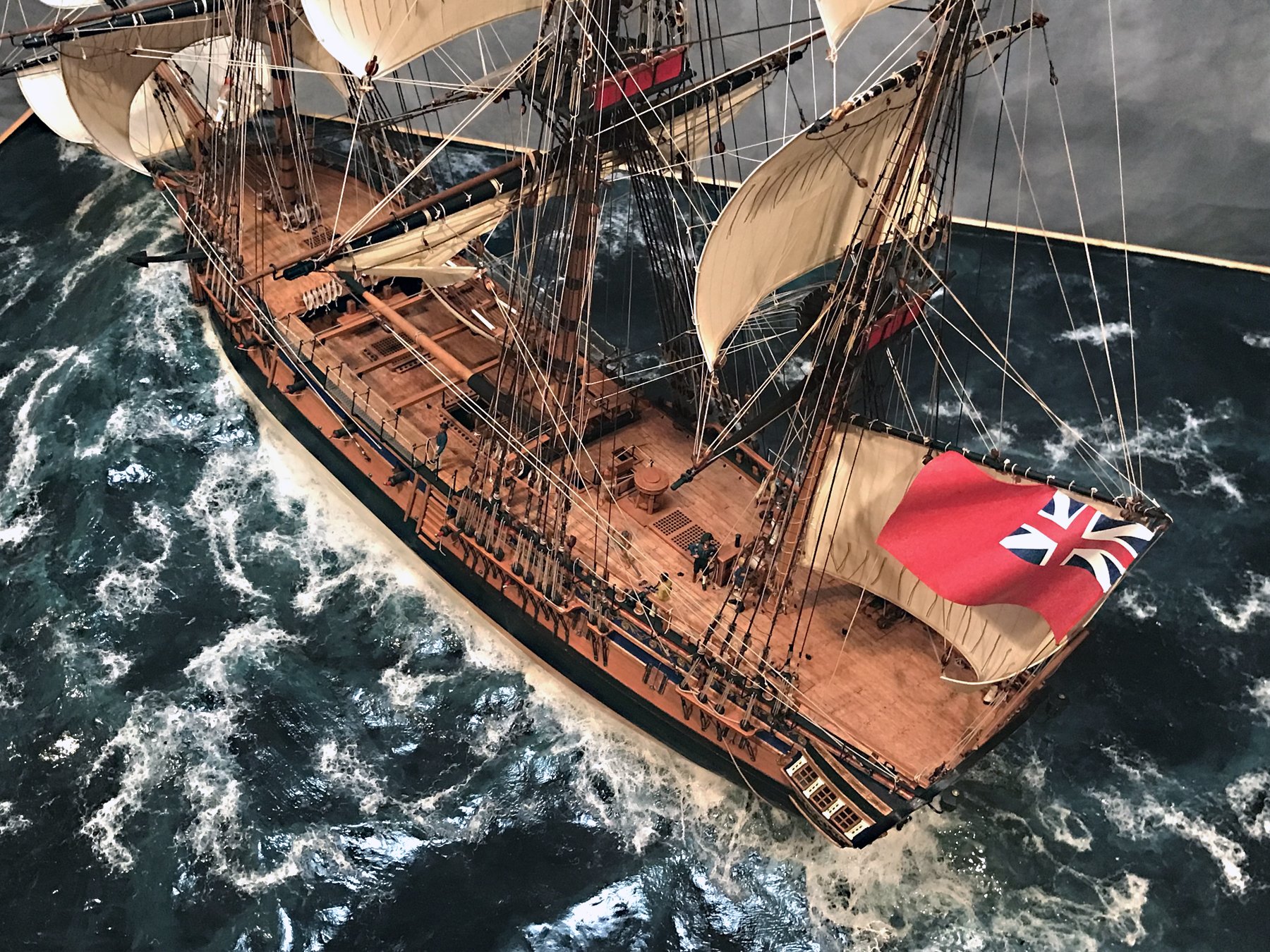
.jpg.d84ec4dad1d7791e855dca06210ab6f3.thumb.jpg.f45209242e851d4409eca1a09293165b.jpg)
